56th Evacuation Hospital Unit History

Cover of the Book “The Story of the 56th Evac” dedicated to to the members of the 56th Evacuation Hospital, published by W. A. Shriver, Buffalo, New York, U.S.A., and printed by Holling Press Inc., Buffalo, N.Y.
Introduction & Activation:
When the Board of Trustees of the Baylor University College of Medicine, Dallas, Texas, received a telegram from the Surgeon General James C. Magee, that an Executive Committee be appointed to organize an Army medical unit to be designated the 56th Evacuation Hospital, it was time to act.
In August of 1940, Dr. Henry M. Winans, MD, Professor of Medicine, was appointed to organize the new Hospital. The Physicians and Surgeons who had volunteered as members of the 56th Evacuation Hospital were given their commissions in the Army of the United States in February 1941. After the Japanese bombed Pearl Harbor on December 7, 1941, Lt. Colonel H. M. Winans’ work of organizing the new Hospital was greatly accelerated. Nurses and additional Medical and Surgical Officers volunteered their services. On March 17, 1942, all Commissioned Officers and Nurses were ordered to report for duty at Fort Sam Houston, San Antonio, Texas (Military Reservation; total acreage 23,592; troop capacity 719 Officers & 25,825 Enlisted Men –ed), and Lieutenant Colonel Henry M. Winans, MC, became the Commanding Officer. General Order No. 12, Headquarters, Eighth Corps Area, dated March 29, 1942, activated the 56th Evacuation Hospital. As expected, 30 new Officers reported for duty at Fort Sam Houston, April 10, 1942, and along with 94 Enlisted Men and 2 additional Officers, a Training Program was begun. During the months of April – May – June – and July of 1942, many new Officers, Nurses, and EM joined the organization. Colonel Henry S. Blessé, MC, joined the 750-bed 56th Evacuation Hospital on May 4, 1942, as the new Commanding Officer. Following the Louisiana Maneuvers, the new organization now consisted of 48 Officers – 49 Nurses – and 315 Enlisted Men.
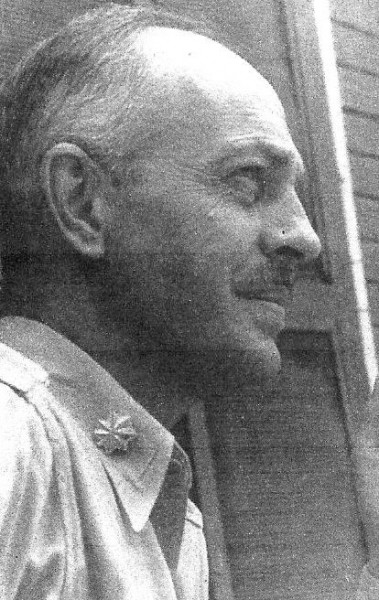
Picture of Lt. Colonel Henry M. Winans (1893-1965), first Commanding Officer, 56th Evacuation Hospital. Dr. Henry Winans was a Dallas, Texas, Physician and Teacher. After receiving his medical degree at Johns Hopkins University, H. Winans returned to Dallas in 1920 to set up a private medical practice. Dr. H. M. Winans began teaching at the Baylor University School of Medicine in 1921 and served as chair of its Department of Internal Medicine in the late 1930s and early 1940s. He joined the U.S. Army during World War II and organized the 56th Evacuation Hospital (Baylor). This medical unit served in North Africa and Italy, including action on the Anzio Beachhead. He was promoted Lieutenant Colonel in 1945. Dr. H. Winans was chief of staff at Baylor Hospital from 1929 through 1955, and served on the Baylor Hospital Medical Board for seven terms. He received numerous academic, military, and medical service awards during his career.
Training and Maneuvers:
At the start of the Training Program, bets were already organized, stating that “the fighting 56th” would be overseas in from six to eight weeks! Meanwhile the training was well received, interest was high, friendships were formed, rumors abounded, and there was a growing feeling of unity, comradeship, and power within the organization – the 56th Evacuation Hospital was no longer just a name, but a UNIT!
To the general disappointment, as everyone was eager to move overseas, orders were received on July 23, 1942, to proceed to Mansfield, Louisiana, for participation in US Army Maneuvers. The Officers and Enlisted personnel moved by truck convoy to Mansfield, covering 300 plus miles, with a first bivouac at Houston Memorial Park, Texas, where both Officers and Enlisted Men had to pitch their pup tents. The ANC Officers had meanwhile reached Mansfield by train along with most of the Hospital’s equipment on July 25, 1942. Upon arrival, the Nurses were taken to the Mansfield High School where they were billeted in the gymnasium.
The 56th opened July 29, 1942, after five bewildering days of backbreaking work, to prepare everything. No sooner was the Hospital declared “operational” than Lieutenant General Walter Krueger ordered the Red and Blue Forces to start the battle. The three weeks of operation at Mansfield were in fact more of an “exploratory” phase, during which time some 50 patients a day were received for treatment. A rumored move, possibly to a Port of Embarkation, materialized when an advance party left to prepare a hospital site in a deserted CCC camp near Fort Jessup, Louisiana. The advance detail embarked for their destination, only to find empty buildings full of rubble, trash, an dirt. Newly-assigned EM joined the detail on August 17, to help clean up the mess, and prepare the hospital area. The many big and small but important details were being ironed out, weaknesses discovered, and a smooth functioning organization was slowly but surely asserting itself. While located near Mansfield, the unit issued a mimeographed newspaper “The Latrine Journal.” For recreation, there was football, and trips and passes to Natchitoches, New Orleans, and Shreveport.
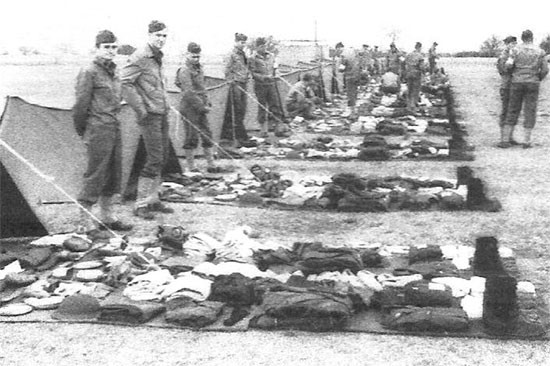
April-May 1942, inspection day at Fort Sam Houston, San Antonio, Texas. Enlisted Men stand ready in front of their individual pup tents.
On October 12, 1942, the Hospital moved with the victorious Red Forces to Jasper, Texas. Maneuver problems were gradually approached more seriously and were carried out efficiently. While at Jasper, the 56th was established at the Fair Grounds. The local citizens displayed a great interest in the operation and many visitors came to the area on Sunday afternoons to watch the various activities. Local newspapers devoted some columns to the Hospital, its functions, and key personnel, and morale was high. Maneuvers ended November 8, 1942.
The main body of the 56th Evacuation Hospital returned to Fort Sam Houston on a bitterly cold morning, it was November 11, 1942. One of the first activities was the exchange of summer cotton uniforms for woolen ODs. It was good to be back from the “war”, with all the regular conveniences, such as telephones, wooden floors, furnaces, toilets, glass windows, and a PX. Furloughs and leaves were granted during fall and the early winter months. Many Enlisted Men were sent to OCS, while others left for Special Schools. Thanksgiving, Christmas, and New Year dinners were splendid feasts, and everything was done to provide staff and personnel a maximum of good food, entertainment, and recreation. The men were aware of the battles in North Africa, and although the outcome was still to be determined, they were eager to receive orders to move overseas.
Preparation for Overseas Movement:
On February 19, 1943, shortly after the third Training Program was started, the organization received its Alert Orders. During the subsequent Officer briefing at Brooke General Hospital Colonel H. Blessé briefly and calmly issued the necessary instructions: “Equipment ready for February 27 – Personnel ready for March 13.”
Packing crates, stenciling shipping numbers (unit designated by code 5290G –ed), drafting inventory lists, allotments, powers of attorney, insurance policies, physical check-ups, articles of war, and last wills, followed each other. B bags, personal baggage, mosquito bars, individual equipment, each had its place in the days preceding final departure from Fort Sam Houston.
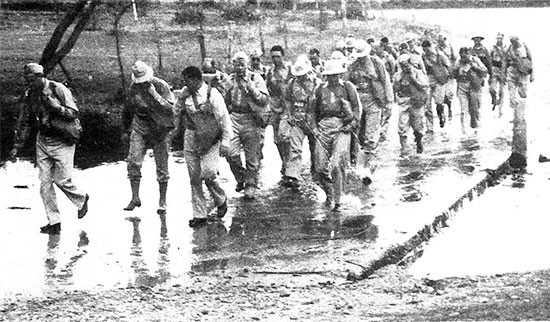
April 1942, picture illustrating Officers on a training march, Fort Sam Houston, San Antonio, Texas.
The train with Pullman and baggage cars arrived on the morning of March 30, 1943 and were soon made ready for the 56th Evac. Kitchens were installed, seating plans checked, supplies inventoried, and everything prepared for the trip. All personnel boarded the train at 1230 hours, March 31, 1943 which then promptly began to move out, causing the necessary relief and excitement among the passengers. It was a very warm day in spring and rumors were that after clearing the yards at San Antonio, the next stop would be at some Staging Area near New York. During the journey, there were at least two exercise halts for some calisthenics.
The organization arrived at Camp Shanks, Orangeburg, New York (Staging Area for New York Port of Embarkation; total acreage 2,009; troop capacity 2,545 Officers & 46,367 Enlisted Men –ed), at 2200 hours, April 3, 1943. The men were the first troops to occupy Area Number One. Officers, Nurses, and Enlisted Men were all billeted in different buildings. Area Number One had a very large mess hall capable of feeding 7,000 men at one meal. There was a very luxurious and well-equipped Post Exchange, supplemented by a counter where sandwiches, pastry, and coffee were sold. The very last passes for New York City were issued April 4, before the men were kept inside until departure. On April 15, 1943, the 56th left Camp Shanks, after going through final preparations involving last minute packing, washing clothes, physical check-ups, issue of gas-proof clothing, immunization shots, last censored letters home, and rehearsals on how to board ship. Then the troop train left Orangeburg for the Weehawken Ferry building.
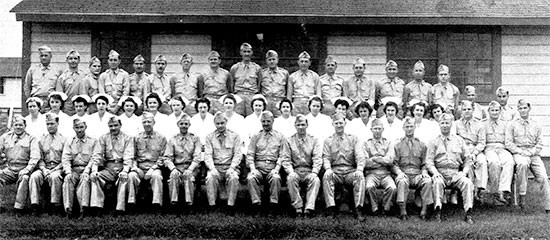
July 1942. Group picture illustrating Officers and Nurses of the 56th Evacuation Hospital prior to departure for the 1942 Louisiana Maneuvers. On July 23, 1942, the organization received its marching orders for Mansfield, Louisiana, from where they moved on to Fort Jessup, Louisiana (a deserted CCC camp), in order to set up a hospital in the area. The men were back at Fort Sam Houston, by 11 November 1942.
The ship was the S/S Mariposa, a former Matson luxury liner and a fast ship that would sail alone and not in convoy. Rumors were rife at night as to the ship’s final destination, and the next morning, this was April 16, 1943, while at breakfast, the engines began to vibrate and the ship set sail. Instructions followed; “Wear your life belt” – “Don’t throw anything overboard” – “Observe boat drill – “Lights out” – “Port holes closed” – “General quarters.” The Mariposa was well loaded. There were a number of other medical units on board, including the 95th Evacuation Hospital, and some Army Air Force Squadrons, among which the colored 51st Fighter Wing commanded by Lt. Colonel Benjamin O. Davis, Jr. Only one or two days from eventual destination, the men learned that they would leave ship at Casablanca, French Morocco.
On April 24, 1943, eight days after leaving Staten Island, it was time to leave the Mariposa – reveille on board was at 0400, breakfast at 0530, and at approximately 0730 a grayish haze appeared on the horizon, and upon approaching the coastline, spires and minarets, mosques and modern buildings, low green hills, and patrolling Allied aircraft, looked very comforting. Small ships escorted the troop ship slowly toward shore and the harbor. By 1000 hours in the morning, the 56th was ready to debark, with helmets, gas masks, pup tents, field pack, and individual gear, and impregnated gas-proof clothing. A band played a hearty number of American tunes. Lunch came and passed on, and finally, at 1430, the orders came to move out. The 56th Evacuation Hospital had arrived overseas, in Casablanca, French Morocco, North Africa.
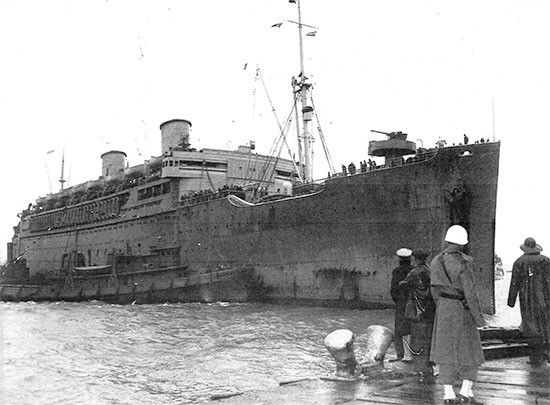
Picture of S/S Mariposa, which carried the 56th Evacuation Hospital from New York, ZI, to Casablanca, French Morocco. Because she was a fast ship, the journey only lasted eight days, from April 16 to April 24, 1943.
French Morocco:
Following debarkation, the Nurses entrucked for Casablanca where quarters had been provided for them in the “Ecole Primaire – Internat.” Officers and Enlisted Men formed two columns for the 3-mile march to Camp Don B. Passage. Marching in the hot sun, with helmets, woolen clothing, and haversack on the back, wasn’t easy. Finally, Camp Don B. Passage with its low unfinished buildings and rows of pyramidal tents came in sight.
It was Easter morning, April 25, 1943, when the first bugle notes called reveille. There was quite some work to be done in camp, even though it was Easter Sunday. Some supplies had already arrived from the docks the previous afternoon, and the remainder would be forthcoming. Reveille, roll call, breakfast, all followed the daily routine, then it went quickly; pitching ward tents in which to store medical supplies. Some of the men under command of an NCO had stayed aboard the Mariposa overnight to guard Afrika Korps PWs who were being sent to the ZI with the ship. Religious services were arranged for and celebrated by Chaplain (Captain) George C. Griffith, ChC. Then the first day began to slip away. At first the newcomers were restricted to the camp area; but even so, a certain amount of interest was developed in and around the camp, especially with regard to the local population. Quite a number of locals were employed in the construction of Camp Don B. Passage, and it was interesting to watch them at work. The men gradually learned their habits, the way they walked and talked, but also witnessed the filth and poverty of the lower classes. It was sometimes wondered how Arab women could carry such heavy burdens on their head. On the other hand, it was necessary to watch one’s belongings, as many tended to disappear. Bargaining with the local population became a daily habit. There were eggs, tomatoes, dates, figs, walnuts, and leather objects to buy, and these were available in quantity. Naturally, the Arabs would take the money, but some of the American commodities were more desirable, and in the end the CO was forced to post a notice on the bulletin board prohibiting the disposal or barter of Government property, such as mattress covers, clothing, blankets, cigarettes, chocolate bars, etc.
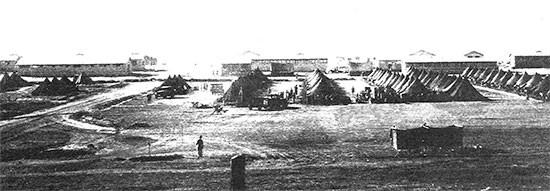
Picture partially illustrating Camp Don B. Passage, the 56th Evacuation Hospital’s first bivouac site in French Morocco. The unit eventually left the camp on June 4, 1943 by motor convoy for Bizerte, Tunisia, a journey of some 1,300 miles.
Atabrine tablets were served for the first time, and the results within the next twenty-four hours were disastrous. Both staff and personnel were continually going to the latrines. Early May, the first passes were issued and the men then piled in trucks for a twenty-minute ride to the American Red Cross post in Casablanca. From there on it was sightseeing either in a donkey-drawn cart, an open carriage, a taxi, or on foot. The streets were very busy with a great variety of traffic, including GI trucks and carriages, carts, bicycles, camels, and pedestrians. Eventually more recreation was introduced, such as dances, sightseeing excursions, and swimming parties.
Life at Casablanca however was not all play. A good number of EM of the 56th Evac were called on each day to help with the manual labor to keep supply lines open. Places like the gas dump, the signal warehouse, the pipeline dump, and the docks were always crying for hands to lighten the practically insurmountable tasks. The Officers also worked, being required to patrol the streets of Casablanca for the purpose of enforcing military courtesy among the Army personnel.
Colonel H. Blessé, MC, inaugurated a new training program for all Officers. He ordered a 5-mile road march with full field pack; the first day of training; with hikes of 10 – 12 – and 15 miles the following days. These exercises were repeated each week!
On May 12, 1943, victory over the German Afrika Korps was announced, and the question became: “Where does the 56th go from here?” A great celebration took place in Casablanca, with long lines of Allied aircraft flying overhead and Allied troops parading down the city’s broad avenues.
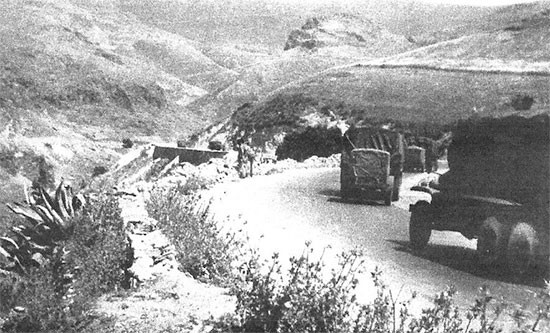
June 1943, trucks and trailers of the 56th Evacuation Hospital, enroute from Casablanca, French Morocco, to Bizerte, Tunisia.
Stations in French Morocco – 56th Evacuation Hospital
Camp Don B. Passage – May 8, 1943 > June 4, 1943 (more training, only brief operation )
Before final orders arrived, the men began to talk about Bizerte, Tunis, or even Sicily as a possible destination… Memorial Day was celebrated and finally the days of the unit’s stay in Casablanca drew to a close. Alert orders were received and instructions followed ordering everyone to pack for a move by motor convoy to Bizerte, in Tunisia. This represented a distance of 1,300 miles! Since the 56th Evac only had about 20 experienced truck drivers, volunteers were called for, with Medical Officers being assigned. In the final count, enough drivers were selected for 112 vehicles. Then on June 4, 1943, the Hospital swung into action, starting the first lap of its North African journey.
Motor Convoy Journey from French Morocco to Bizerte – 56th Evacuation Hospital
(Camp Don B. Passage) Casablanca, French Morocco > Meknès – June 4, 1943
Meknès, French Morocco > Guercif – June 5, 1943
Guercif, French Morocco > Tlemcen – June 6, 1943
Tlemcen, Algeria > Orléansville – June 7, 1943
Orléansville, Algeria > L’Arba – June 8, 1943
L’Arba, Algeria > Sétif – June 9, 1943
Sétif, Algeria > Souk Ahras – June 10, 1943
Souk Ahras, Algeria > Bizerte, Tunisia – June 11, 1943
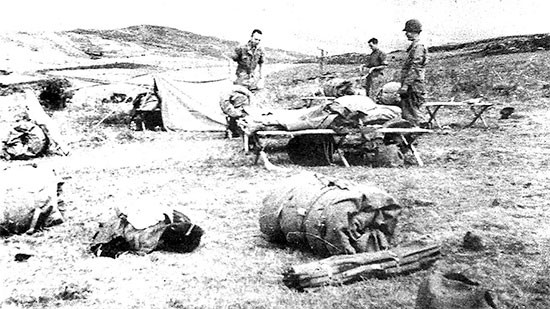
June 10, 1943, Souk Ahras, Algeria, last overnight bivouac before reaching Bizerte, Tunisia.
Each truck was provided with a driver and his assistant. The trailers were heavily loaded with supplies. A few empty trucks were reserved for carrying the Nurses and their equipment. The convoy itself, was divided into 4 serials of about 30 trucks each. A briefing was given by Captain Clarence E. Soper, QMC, ending with a pep talk. The first destination was to be Meknès, via Rabat. The group consisted of 46 Officers – 47 Nurses – and 315 Enlisted Men. Stops were arranged underway for meals during which the men and women ate C-rations. After reaching Meknès, the convoy had to bivouac several miles east of the city in a broad flat valley. The site had been prepared by an advance detail who had pitched ward tents provided with cots and blankets. Following arrival the trucks were first replenished with gasoline, water, and oil. Local inhabitants appeared from nearby farms offering onions, eggs, tomatoes, and oranges. Everyone went to bed early as reveille was set for 0530 the next morning.
Several hundred miles had been driven when the convoy rumbled into Tlemcen late in the afternoon on June 6. A race track served as a bivouac that night. The neighbors were part of the 36th Infantry Division. The good news was, that following arrival, there was time for a real bath that night. It was a concrete reservoir fed by a clear and cold mountain stream. The journey then continued in mountainous country with magnificent views of the surroundings.
Reaching Orléansville proved the longest lap of the trip. It was already 2130 before all the trucks were ready to roll again and safely grouped in the bivouac area, an ancient olive grove. Bugle call came at 0500 the next morning following a tiring journey and a short night. The greater part of the trip was now made over tortuous roads up the sides and down the slopes of steep mountains; a dangerous experience. Another bivouac was set up at L’Arba in Algeria where the men witnessed the extensive vineyards and orange groves. Limited bathing facilities were discovered in the form of an ice-cold irrigation ditch. The 56th Evac convoy bivouacked a few miles beyond Sétif in open country. In this region were many cattle, sheep, and horses.
Thursday morning, another long drive was under preparation. This one would take the trucks to Souk Ahras, also in Algeria, by way of Constantine. Just beyond the city, a very large company of German Prisoners of War was met, surprisingly guarded by only a few British soldiers. Soon after the PWs were passed, the convoy stopped for lunch. After driving into high mountains once more, the end of the day was reached, with the 56th setting up a bivouac in an exquisitely beautiful high mountain scenery.
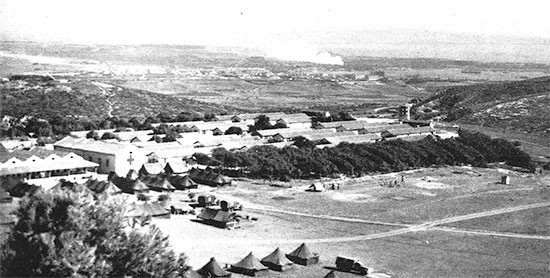
View of Camp Nador, a former French garrison post situated on a hilltop, which would become the 56th Evacuation Hospital’s home in Tunisia from June 11 to September 17, 1943.
Friday, June 11, 1943, was the last day of this long journey. While the trucks were warming up, a shower of rain over the high mountain peaks brought forth a brilliant rainbow. Then, a flight of American fighter aircraft came into view through a bank of clouds. The road in the mountains grew rougher every mile. On the way, the 56th convoy met truckloads of German and Italian PWs coming from the front in Tunisia, and there were more and more signs of war. As the trucks continued eastwards, battle scars became more conspicuous in the form of wrecked tanks, half-burned aircraft, and battered trucks. Mateur came in sight at 1630 hours, and the men passed a hill where some heavy fighting involving armor had taken place. Some Arabs were busy digging up mines along the road, and isolated American, German, and Italian graves were not infrequent. The rough road eventually turned into a highway beyond Mateur, Tunisia. Then the convoy entered the outskirts of Bizerte, one of the worst bombed cities in North Africa.
The 56th finally crawled through the many debris of war that was once Bizerte at 1800 hours that same day, beginning the ascent up the winding road to Camp Nador, on a hilltop, 6 miles northwest of the city and originally a French garrison post. The numerous white stucco buildings appeared well-suited for the purposes of a hospital and had therefore been selected.

September 24, 1943, picture illustrating some Officers of the 56th Evacuation Hospital, ready for the move to Italy which took place September 25-26, 1943.
Tunisia:
During the first week spent at Camp Nador, an Ambulance Company cleaned up one building and set up showers so the men could enjoy a hot bath in camp. After that the 56th undertook the task of cleaning up the whole place. Officers and Enlisted personnel worked every day for a week on the buildings and adjacent grounds until the filth left behind by the Germans showed some signs of being disposed of. The 175th Engineer General Service Regiment lent them a hand in the process until Camp Nador finally began to take on some aspects of an American hospital. During this clean-up campaign, the men kept their eyes peeled for souvenirs to send home. Many a German helmet, a gas mask, flour sacks marked with the German eagle and swastika, bayonets, and handguns were collected. Nothing was overlooked. Fortunately no booby-traps had been left in the place.
The ANC Officers meanwhile enjoyed the privileges of a rest from the long trip and were taken swimming at the beach by the 175th Engineers. They were also driven around by them to visit the ruins of Bizerte, the ancient ruins of Carthage, and the city of Tunis.
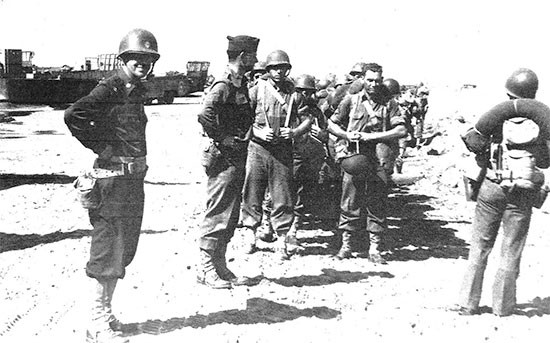
Picture illustrating personnel of the 56th Evacuation Hospital having just landed at Paestum, Italy, September 26, 1943.
At last the day came to move into the cleaned quarters. Officers and Nurses had gained permission to bring up some furniture from Bizerte, so that in a short time the rooms began to look as homelike and hospitable as could be. Enlisted Men, not to be outdone, provided themselves with a great variety of furniture contrived from miscellaneous crates and boxes. Then came the day that the CO decided that everything had to be more GI and a great public bonfire soon reduced the EM to the bare necessities of Army life, in other words – a folding cot, two Army blankets, a mosquito net, and a barracks bag.
The wards were set in order and the 56th Evacuation Hospital was officially opened on June 20, 1943. The same day, Ward # 24 received its first patient: Private Nick J. Gergulas, the “Greek”, victim of sandfly fever, a tropical disease the Doctors had never met in the ZI. More patients soon began to arrive, and the Medical Service was crowded to overflowing. The Hospital had finally begun to fulfill its mission! A PA system was installed by Technician 5th Grade Joseph S. Polecki and his electricians. Music also became available. V-Mail started to arrive with plenty of letters from home, boosting morale. On July 10, 1943, a first news program was presented via the own Public Address system with help from Private First Class Samuel Ennis and Corporal Earl Kenney. Later Corporal George Walton joined the news staff. The program enjoyed genuine prosperity and became the most awaited time in the day.
Stations in Tunisia – 56th Evacuation Hospital
(Camp Nador) Bizerte – June 20, 143 > September 17, 1943 (750-bed unit)
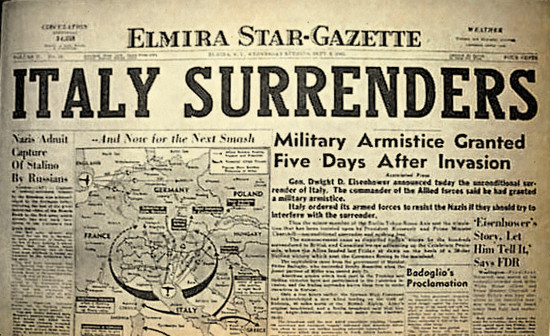
Vintage newspaper Elmira Star-Gazette (Elmira-New York) dated September 8, 1943, announcing the surrender of Italy, which now sided with the Allies as a co-belligerent force.
By mid-July big white Hospital Ships and troop transports steamed into Bizerte harbor; and ambulances began to roll uphill bringing in patients from the Sicily Campaign. Americans predominated, but now and then, Germans, Italians, and British patients were received.
On July 6, 1943, shortly after 0300 in the early morning a great air raid took place, filling the night with bright flares, powerful searchlight beams, ack-ack fire, colorful tracers, and falling bombs. It was time to adjust a steel helmet. The whole raid lasted over an hour, and the onlookers’ enthusiasm subsided when they saw the long lines of ambulances streaming into the facility bearing mangled human bodies. Sometime later a USO show was on, and as it was too dangerous to stay in Bizerte, the group composed of Bob Hope, Frances Langford, Jack Pepper, and Tony Romano, spent five nights at the Hospital. They really made the 56th their headquarters, visiting other units in the area.
About mid-August, the Enlisted Men were favored with a dance or two under the direction of Special Service Officer, Second Lieutenant Lucas J. Baird, MAC, and everybody had a swell time. The Officers and Nurses also enjoyed several evenings of dances in the EM’s mess hall. Bands and choral groups came to perform on several occasions. Swimming almost took place every day, trips, visits, tours, and meetings with British AAA crews and French troops were organized, and outdoor movies shown.
When the Sicily Campaign ended, and Salerno was assaulted, the organization knew that it would soon leave North Africa. Rumors were plentiful, and mentioned the United Kingdom, Burma, or just plain San Antonio, Texas, but the Army thoughtfully had the 56th Evac scheduled for Italy.

October 8, 1943, partial views of hospital buildings in use by the 56th Evacuation Hospital, at Avellino, Italy. Left: buildings of the Surgical Service; right: those used by the Medical Service.
On September 8, 1943, General Dwight D. Eisenhower publicly announced the surrender of Italy to the Allies. With Benito Mussolini deposed from power and the collapse of the Fascist Government in the country, Marshal Pietro Badoglio had begun secretly negotiating with the Allies finally approving the conditional surrender of Italy (signed September 3, 1943, at Cassibile, Sicily), allowing Allied Forces to land in southern Italy and begin beating the Germans back up the peninsula. From September 28, 1943, the Italians fought as co-belligerents with the Allies.
The 24th General Hospital arrived to take over the buildings at Camp Nador, and on September 17, 1943, the Hospital moved under canvas in the original bivouac area. On September 24, 1943, the 56th Evac received alert orders; it was time to move.
Supplies had been crated, inventories checked and the site policed and on the same day the unit was off to the ships awaiting in the Port of Bizerte. Officers an d Enlisted Men were to sail on three different LSTs, while the Nurses would board LCT # 238. After having spent the whole night aboard ship in the harbor, the group was relieved when the convoy set sail in the afternoon of September 25, 1944. When night came on, many were sleeping on deck among the vehicles and supplies, while only a few were fortunate enough to have obtained bunks. The crew told the men that they were headed for Paestum, Italy, some thirty miles below Salerno.
Italy:
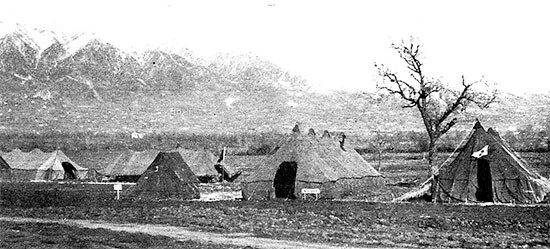
Partial view of the 56th Evacuation Hospital’s setup at Dragoni, Italy. Picture taken some time early November 1943.
By Sunday mid-afternoon, September 26, 1943, the mountain-lined shores of Italy came in sight and villages could be seen. Also the first signs of ancient ruins became more distinct. British barrage balloons hinted at the great number of ships at anchor in the bay. When the convoy came in, LSTs were busy debarking troops and supplies along the sandy beaches. This was the unit’s first amphibious landing. The first shipload went ashore the same evening at sundown and hiked to a bivouac south of Paestum, where they spent the night sleeping on the ground. The area was already occupied by the 93d Evacuation Hospital which had started receiving patients as early as September 16, 1943. The other ships beached the following day. The ANC Officers waded ashore from their LCT following marked paths leading through some mined terrain up to the main road. Upon arrival, they were welcomed by personnel pertaining to the 95th Evacuation Hospital who provided them with hot coffee and food, and since beds were scarce, with two blankets to have some night’s rest on the ground. Alerts had been sounded at frequent intervals all day, and it was good to be on land. By the evening, this was September 27, the various groups of the 56th had been assembled at the bivouac area just a few miles from Paestum. Supplies had been unloaded, and ward tents provided for the Nurses. Foxholes were hastily dug in anticipation of enemy raids. The weather was sunny, warm, and beautiful, and sleeping under the stars looked attractive to many.
Then the rains came! That same night, around 2200 hours, a storm descended upon the area. Blinding lightning, deafening thunder, violent wind, and driving rain, came down. Some people found shelter in an old barn, others crawled under tarpaulins, and a few stuck with the beached ship until the storm subsided. The next morning, mud-soaked bedding, destroyed mosquito bars, and miscellaneous clothing were strewn all over the place. The 38th Evacuation Hospital, situated nearby, had fared no better with much of their equipment having been blown away or destroyed by the storm. While in bivouac, the 38th Evac borrowed some equipment from the 56th still inactive to set up its hospital which opened September 29.
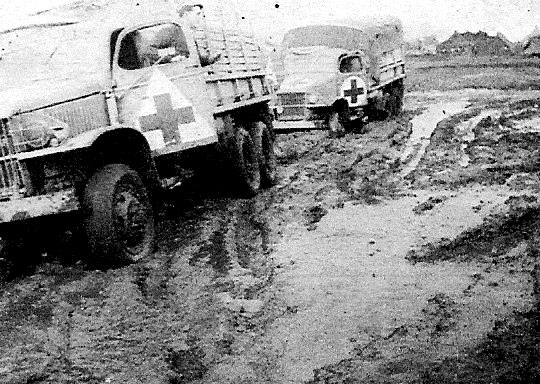
November 1943, trucks of the 56th Evacuation Hospital stuck in the mud in the area around Dragoni, Italy.
On October 1, 1943, Naples was captured by the Allies, and rumors flourished relative to the Hospital’s next move. Friendly peasants in nearby farms had meanwhile accepted the newcomers, offering wine, pasta, and to wash the clothes. There were plenty of tomatoes and potatoes to be had near the bivouac and many enjoyed fresh vegetables. When traveling around, there were always crowds of war refugees pouring southward and away from the fighting and German-controlled territory. French words and vocabulary now underwent some changes, as Italian was to become the norm.
On October 2, 1943, a small detail had been selected to visit Avellino, a city some thirty miles inland from Naples. They were tasked with cleaning the buildings of an Italian Military Academy for the Hospital. On October 6, the 56th Evac was once again enroute in a long convoy of trucks, supplies, and personnel. The journey which involved traveling forty miles of winding mountain roads, traversed one of the most scenic and colorful country in Italy. As it was harvest time, the farmers were generously providing the group with plenty of fruit along the way.
Stations in Italy – 56th Evacuation Hospital
Paestum – September 26-27, 1943 > October 6, 1943 (bivouac)
Avellino – October 7, 1943 > October 11, 1943 (1100-bed unit)
Dragoni – November 4, 1943 > January 19, 1944
Caivano – January 20, 1944 > January 24, 1944 (staging area)
Anzio – January 25-28, 1944 > April 9, 1944 (beachhead)
Nocelleto – April 12, 1944 > May 26, 1944
Fondi – June 1, 1944 > June 6, 1944
Rome – June 6, 1944 > June 27, 1944
Piombino – June 29, 1944 > August 3, 1944
Peccioli – August 5, 1944 > September 23, 1944
Scarperia – September 24, 1944 > April 21, 1945
Bologna – April 25, 1945 > May 19, 1945
Udine – May 29, 1945 > August 4, 1945 (last patient received)
Montecatini – August 6, 1945 > (sent home to the ZI for inactivation in October 1945)
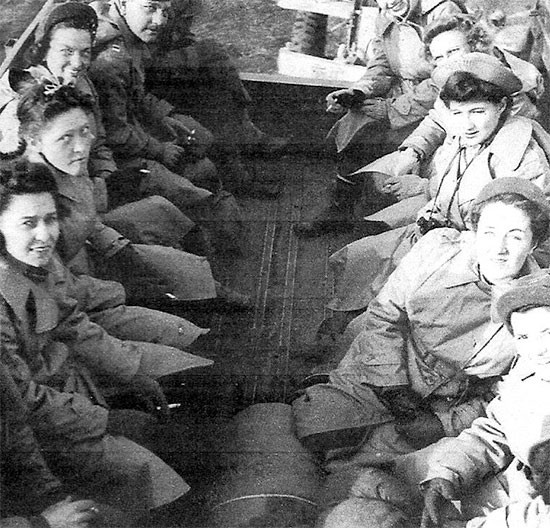
Dragoni, January 19, 1944, ANC Officers traveling on trucks of the 56th Evacuation Hospital enroute for the unit’s staging area at Caivano, Italy (in preparation for the move to Anzio).
The Hospital was billeted in the “Scuola Allievi Ufficiali”, on the edge of the city of Avellino. By midnight October 7, the Receiving Department had already admitted close to 300 patients. During the next day, the 56th expanded from 750 to 1100 beds, and tents had to be pitched to supplement the lack of space in the bomb-damaged buildings. Then the fall rains began to come down in earnest. The buildings leaked, the weather was cold and damp, and the C-rations tasted bad. Fortunately, a water buffalo was purchased and slaughtered. The meat was no good, but far better than the tiresome C-rations! Some of the medical wards were now filled with several hundred malaria patients, and surgery was working night and day on the steady stream of incoming wounded soldiers.
The 93d Evacuation Hospital had meanwhile arrived in Avellino on October 11, 1943, from where it moved further to Piana di Caiazzo.
Avellino also had a large supply dump, established early October, which was operated by the 12th Medical Supply Depot Company. They controlled stores representing 50 tons of medical supplies.
Recreation and passes were provided and after first visiting Naples, tours to ancient Pompeii and Herculaneum, as well as Mount Vesuvius, became part of sightseeing. Gradually, the front moved further ahead, and patients practically ceased to arrive at the Hospital. Other hospitals, being much closer to the fighting were taking over, so it was time to be on the way again. An advance party was sent to Caserta to prepare a further move. The battle line was moving rapidly to the north and reservations at Caserta were consequently cancelled. The 56th Evac was ordered ahead, beyond Caserta, across the Volturno River, up to the village of Dragoni, where it was to set up under canvas.
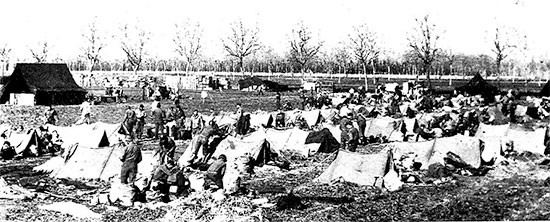
Picture illustrating the Enlisted Men’s bivouac site at Caivano. The 56th Evacuation Hospital remained in its staging area from January 20 to January 24, 1944, while preparing for their journey to the Anzio Beachhead.
Following the move to its new location at Dragoni November 2, the organization had three beautiful days to set up. The new site was a field with only a few shell craters, nearby was a deserted farmhouse, with a knocked-out enemy tank. The village was a mere cluster of stone houses a few hundred yards away. The hospital site was a flat valley through which the Volturno River ran its winding course, surrounded on all sides by steep and rugged ranges of the Apennines. The Hospital started receiving patients on November 4, 1943 rapidly filling the different wards. As a result, surgical personnel worked around the clock.
The front lines were not far away, and artillery flashes were visible in the hills ahead, while the rumble of big guns was to become a customary sound at night. Bombing and strafing was sometimes watched by off-duty personnel and patients. Then the weather changed, and with it came rain, mud, and cold. On November 5, the 56th had hardly begun to function, the first rains were intermittent, but as the days went by, they settled in an almost steady downpour. There was about a single nice day out of every ten. The hospital area slowly became transformed into one vast quagmire. An improvised access road for ambulances and supply trucks ran through the center of the hospital complex; churned by thousands of tires and trampled by hundreds of feet, it gradually became a deep bog dotted with lakes of liquid mud! The EM spent many back-breaking hours hauling gravel to make paths, only to see the gravel sink out of sight in the deep mud. The Engineers were called in to help but it still it rained, washing everything away. Torrents came down forming rivulets that broke over trenches, ran through tents, and even carried personal items out of the men’s canvas homes. Litter hauls were long and slippery. Since there were no overshoes, dubbing was applied repeatedly to shoes, but proved ineffective. It was cold too, and keeping warm became a problem. Stoves were available but fuel was often scarce, and firewood had to be scrounged. Anything that burned was retrieved from the farmhouse, but it was limited.
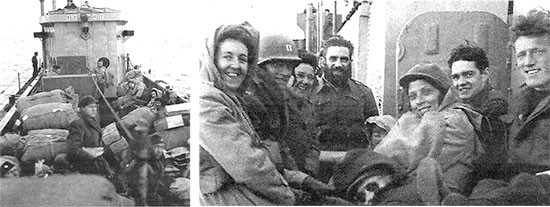
January 25, 1944, picture illustrating 56th Evacuation Hospital Officers and Nurses aboard LCI # 316, enroute for the Anzio Beachhead, Italy.
During this period, ambulances in steady streams were constantly bringing wounded and sick soldiers from the front. They were weary-eyed, muddy, unshaven, soldiers who had come from a nightmarish experience of rain, cold, mud, sleet, snow, and enemy fire. A new illness made its appearance: trench foot, of which numerous cases would be treated before the war ended. The long dreary days and nights dragged on and to forget about the adverse weather, a library and reading room were constructed. Resources of books were pooled, and ammo cases and packing crates were rapidly converted into shelves, tables, and chairs. When Thanksgiving Day arrived, the rain ceased for a while, and when dinner came, the cooks had prepared a royal feast of turkey, cranberry sauce, potatoes, and even mince pie. Christmas packages from home began to arrive as well as mail. Despite the rain, many men hitch-hiked to Caserta, Santa Maria, Avellino, and Naples. Because of the high patient census, one Clearing Platoon pertaining to the 162d Medical Battalion was attached to the 56th Evac from November 6 until December 21, 1943.
On December 7, 1943, a first overseas wedding was announced. The bride was Second Lieutenant Ruth G. Grifford, ANC, who married a First Lieutenant Evans of the Army Air Forces. When Christmas drew nigh, it was still raining, and there was little real Christmas spirit. Everyone was thinking about home. Nevertheless, parties were planned and Nurses and Enlisted Men cheered up the wards with gaily decorated fir branches. Carols were even sung on Christmas Eve and open house was held in the EM’s day tent, while the Officers and Nurses organized an informal dance. Christmas Day, December 25, 1943, was not cheerful at all, even though the sun broke through the rain clouds. Dinner was wonderful, yet when night fell, everyone seemed glad the day was over.
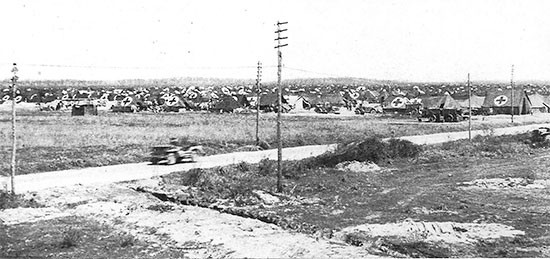
February 1944, partial view of the crowded Anzio Beachhead hospital area. This particular one shows the US hospital sector.
January 1, 1944 was ushered in by a strong wind, rain and hail, a storm which blew down the 15th Evacuation and 38th Evacuation Hospitals not far away. Damage was less at the 56th site although some of the equipment was also blown down and destroyed. The month of January brought a decrease in the number of incoming patients. Rumors sprang up indicating that the days at Dragoni were numbered. When mid-January arrived, it was time to leave the place, and start striking the tents and pack the equipment.
Anzio
Medical planning for the Anzio landings (Operation “Shingle”, January 22, 1944 –ed) followed the tactical plans, making full use of combat experience gained in North Africa, Sicily and on the Salerno (Operation “Avalanche“, September 9, 1943 –ed) beaches. The operation was to be carried out by VI Army Corps, under command of Major General John P. Lucas. The assault troops were to be the British 1st Infantry Division (assigned from Eighth British Army –ed), and the 3d Infantry Division, with the 45th Infantry and 1st Armored Divisions in reserve. The landing force was also to include two British Commando and three Ranger Battalions, the 504th Parachute Infantry Regiment, and the 509th Parachute Infantry Battalion. In addition to the normal medical detachments and organic medical battalions, medical support for VI Corps was to be supplied by the 52d Medical Battalion; the 93d – 95th – and 56th Evacuation Hospitals; the 33d Field Hospital, with the British 12th Field Transfusion Unit attached; the British 2d Casualty Clearing Station; the 549th Ambulance Company (Motorized); and a Detachment of the 2d Auxiliary Surgical Group.
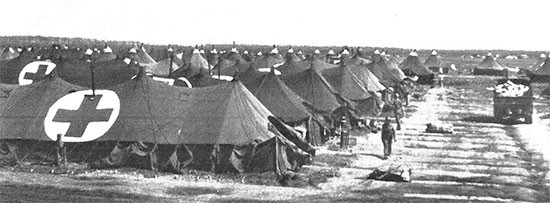
Picture illustrating the Enlisted Men’s area of the 56th Evacuation Hospital while established on the Anzio Beachhead, Italy.
Medical planning for the Anzio operation was directed by Fifth Army Surgeon, Brigadier General Joseph I. Martin, and Colonel Jarrett M. Huddleston, who had been VI Corps Surgeon since Salerno. Colonel J. M. Huddleston also directed medical services on the beachhead until he was killed by artillery fire while emerging from Corps Headquarters on February 9, 1944. He was succeeded by Colonel Rollin L. Bauchspies, Commanding Officer of the 16th Evacuation Hospital.
All medical units were to be combat-loaded for greater speed in establishing themselves ashore. Aid Stations were to go in with the landing waves, to be followed as quickly as possible by the installations of the Beach Group, under initial control of the 540th Engineer Shore Regiment. In the latter category, the 52d Medical Battalion was to set up a Collecting-Clearing Station to receive casualties from the Aid Stations and evacuate them to the ships, while the 33d Field Hospital (two Platoons –ed) was to establish an adjacent unit to care for non-transportable patients. The Collecting Companies of the 3d Medical Battalion (organic unit 3d Infantry Division) were to land at H plus 6 and move inland to assume their normal functions, with the 3d Infantry Division Clearing Station following two hours later. The two 400-bed Evacuation Hospitals, the 93d and 95th, were also to go ashore on D-Day. The 56th Evacuation Hospital would join the other Hospitals at Anzio on January 28, 1944.
The 56th Evac started moving January 19, 1944, leaving Dragoni, Italy, and on their way to their Staging Area at Caivano, near Naples. Personnel and equipment moved by motor convoy consisting of 110 trucks and 20 trailers. While in bivouac, Allied Forces landed at Anzio-Nettuno, Italy, on January 22, 1944, some 30 miles south of Rome, and situated behind enemy lines. On January 24, alert orders were received and last minute preparations were started. Readiness hour was set for 1900 when trucks would arrive for transportation to the Port of Naples. At 2200 hours the unit entrucked and made for Pozzuoli (Naples port area –ed) under blackout conditions.
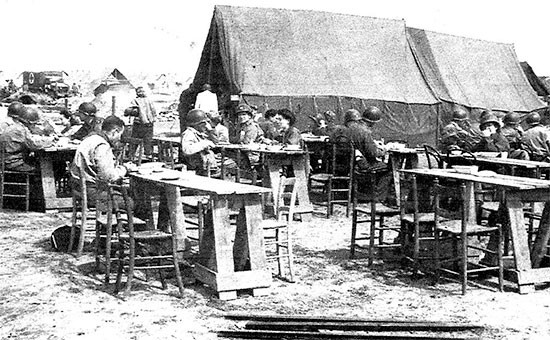
Partial view of the 56th Evacuation Hospital mess area for Officers and Nurses on the Anzio Beachhead, Italy.
An advance party, carrying 1 Officer and 24 EM with supplies and equipment had left Pozzuoli at 0600 hours on January 23, traveling aboard LCT # 581, reached Anzio at 1700, January 25, 1944. LCT # 617 loaded with vehicles and drivers was ready on January 23, but on account of the rough weather returned to port. Her cargo was transferred to LCT # 548 January 25, which only set sail for Anzio two days later, where she arrived January 28, 1944. LST # 11 with another 11 Enlisted Men and supplies left Pozzuoli January 24, and only reached Anzio on January 28, 1944. LCI # 111, with 2 Officers and 135 EM left Pozzuoli at 2200, January 24, but due to the terrible storm at sea, they were only able to dock after the storm subsided disembarking their load around 1400 hours the next day!
LCI # 174, carrying 2 Officers and 132 Enlisted personnel set sail at 0800 hours on January 25, and after suffering an engine breakdown had to return to port. Men and supplies were transferred to another British-crewed LCI, but as she also developed problems, they too returned to port for another transfer, this time to an American-crewed LCI, which carried them to Anzio without incident, where they landed on January 28, 1944. LCI # 316 with some Officers and the ANC complement sailed at 0800, January 25, also undergoing the stormy weather. With many Nurses turning violently sick, the skipper transferred them on to an approaching LST. Twenty-six (26) Nurses were transferred to the larger and more comfortable vessel, leaving their equipment aboard the LCI which continued her route to Anzio. LCI # 316 however could not dock or weigh anchor at Anzio because of the weather and the strong surf, and returned to Pozzuoli. It would take another day before she arrived at Anzio. Meanwhile the LST (with the Nurses) was waiting in the harbor for landing orders, when an air raid took place. During the next thirty-six hours, 14 enemy air raids were experienced, with everyone fearing for the worst, as the LST was carrying ammunition and gasoline. At noon the ship finally docked, allowing the Nurses to land on January 27, 1944.
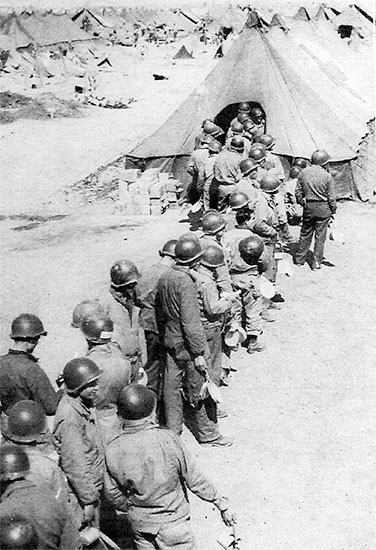
Picture illustrating the 56th Evacuation Hospital chow line for Enlisted Men. Wearing steel helmets eventually became compulsory because of the constant bombing and shelling by enemy long-range artillery and aircraft.
Staff and personnel pertaining to the 56th Evac traveled on board LCTs and LCIs (6-ship convoy) which upon reaching the open waters were met in a turmoil of huge rolling waves bouncing against the ships. The crossing proved miserable. There was no heat, there were no blankets, crowded vessels offered little comfort, and to add to the misery, many members became seasick. Although meals were served, very few men enjoyed them.
The initial site for the 56th Evacuation Hospital was a former TBC Sanitarium which was to be shared with the 95th Evacuation Hospital. It was however learned that the building was a military objective bombed almost on a daily basis, and therefore decided to establish the Hospital at another site some 3 miles east of Nettuno. News of the arrival of Army Nurses on the Beachhead spread like wildfire. Reporters and photographers besieged the ladies of the 56th Evac and within 24 hours a story appeared in the ZI newspapers. It is during their stay on the Anzio Beachhead that the personnel of the 56th made the acquaintance of the “Anzio Express” which fired continuously at the harbor installations. It was later discovered that there were 2 of these large guns that fired. It must be said that the dreaded rushing sound of incoming shells cost the organization much valuable equipment, loss of life, and shattered nerves as well as an intense feeling of insecurity during the 76 days the 56th spent at Anzio.

March 28, 1944, war correspondent Ernie T. Pyle (1900-1945) visits the 56th Evacuation Hospital and the Anzio Beachhead area.
On January 28, 1944, all the personnel and most of the Hospital’s equipment had been unloaded and transported to the installation site, while under frequent shelling and bombing. Many of the surgical supplies had not yet arrived, and everything had to be re-sterilized before usage because of water contamination.
On January 30, the Hospital was almost ready for opening, and the Luftwaffe decided to launch an air raid against shipping in the harbor and offshore. The enemy used glide bombs for that purpose, and one of them landed causing terrific concussion less than 150 yards from the hospital site, causing a large crater. Another of these special bombs hit an ammo ship which exploded, while several other ships suffered bomb damage and fires. Gradually other hospitals moved into the Beachhead, bringing in more ANC personnel.
The FIRST patient was received on January 30, 1944, quickly followed by others. In merely 36 hours, the 56th had admitted 1129 patients, all battle casualties. The problem however was that part of the surgical equipment was still at the docks (it eventually arrived on February 2, 1944 –ed) which affected work. It was therefore decided to submit priority lists per ward, which were then rushed to surgery first. Unfortunately a serious backlog was created, which gradually grew greater. Part of the solution was to evacuate minor casualties by ship to the Port of Naples for treatment.
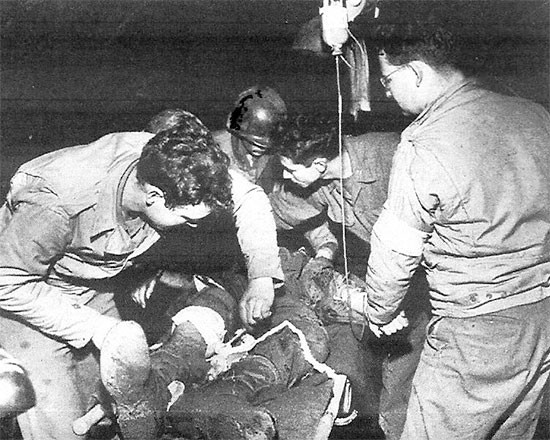
Treating the wounded on Anzio Beachhead, 56th Evacuation Hospital personnel are taking care of a patient.
Because of the dangerous situation foxholes were dug deeper, additional sand bags were installed, and wooden canopies built over the canvas tents (called flak shacks –ed). On February 4, 1944, enemy shells landed in the 33d Field Hospital area; tents burned and equipment was damaged, but no casualties occurred. There was much shelling of the shore installations and supply ships in the harbor, and because the hospitals were in the direct line of enemy fire, the situation remained precarious. Gradually, the medical personnel on the Beachhead became accustomed to the frequent bombings and shellings and less affected emotionally during work. When however the shells dropped short, they inevitably fell in the Hospital area! Some of the EM, such as Technician 4th Grade Cecil B. Baney, Private First Class Chester P. Bujarski, Technician 5th Grade Benjamin L. Hawkins, Private First Class Clarence J. Riley and other drivers made frequent daily trips down “Purple Heart Highway” to bring in water, rations, and mail to the unit.
By February 2, 1944, Fifth United States Army controlled 4 operating hospitals with an aggregate T/O bed strength of 1750.
On February 7, 1944, it was late afternoon, a friendly fighter was hot on the trail of an enemy plane which jettisoned its bombs while trying to escape. Five bombs fell on the site occupied by the 95th Evacuation Hospital wrecking the large GC Red Cross marker, the Receiving Section and the Pharmacy, and destroying 29 ward tents. Immediately aid arrived to help recover the bodies of 16 dead and nearly 70 wounded from the debris. Later more casualties died from their wounds, bringing the dead toll to 26 (including 2 ANC Officers and 1 ARC worker). The wounded were brought to the 56th Evac for care. Major General Joseph I. Martin, after reviewing the situation with his Beachhead Deputy, Colonel Henry S. Blessé, ordered the 95th Evac Hosp replaced, as the personnel losses and damage to equipment were too great to overcome. The unit was later replaced by the 15th Evacuation Hospital.
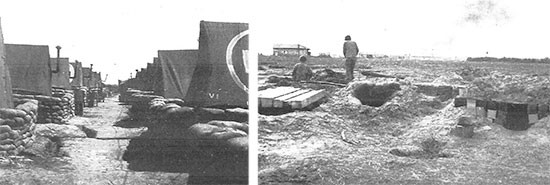
Picture illustrating some aspects of the 56th Evacuation Hospital area on the Anzio Beachhead. Left: ANC tented quarters; right: some of the Officers’ foxholes.
Although equipped for 750 beds, the Hospital was stretched to a 1200-bed capacity, thus requiring additional supplies and personnel. Because of the continuous air raids and shelling, an air raid shelter was constructed for the Nurses. Expansion of the Hospital took place quietly as daily work progressed, with new tents being added to meet the growing needs.
At 1700 hours, February 10, 1944, both the 56th Evacuation Hospital and the 33d Field Hospital were shelled by German artillery (presumably 88mm –ed), with three shells hitting the 56th area and three more landing at the 33d site instantly killing 2 Nurses and 1 Enlisted Man. Another shell hit their generator starting a fire. Again the 56th Evac acted as rescue station, sending teams to the scene. The injured were treated and cared for by the unit. On February 12, it was 1900 hours, the enemy unleashed the heaviest air raid over Anzio. It lasted 1½ hours. One anti-personnel bomb landed in the Officers’ area, seriously wounding Second Lieutenant Ellen G. Ainsworth, ANC. Unfortunately, the best surgical and nursing care were of no avail, and four days later she died (she was buried in the military cemetery at Nettuno –ed). Several personnel suffered light injuries. It was necessary to salvage 33 small wall tents and 3 pyramidal tents and much equipment and personal luggage was damaged or destroyed. Following this last raid, a message was sent to the German Command giving the exact coordinates of the area containing the hospitals, hoping that this would induce the enemy to refrain from further shelling of this particular area. A German counter-attack was meanwhile in the making. While defensive structures and shelters were improved, many high-ranking Officers visited the hospital area to show their concern and improve morale. There was now a shortage of water, with showers available only once a week, and helmet-washing becoming the norm. A $ 25.00 fine was imposed on those found without a steel helmet! Tragic days and restless nights followed each other, accompanied by severe rains, and innumerable enemy sorties over Anzio Beachhead.
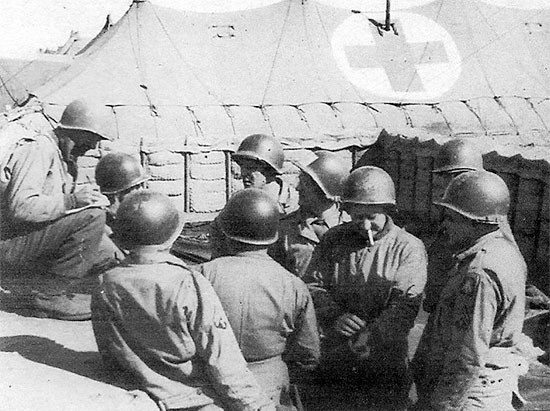
Because of the frequent hazards of enemy bombing and shelling, parts of the 56th Evacuation Hospital were dug in and protected with assistance from the 39th Engineer Combat Regiment.
On February 21, 1944, Major General John P. Lucas, CG VI Army Corps, awarded 3 Silver Stars to Army Nurses. The first citation included that of a 56th Evacuation Hospital ANC Officer; First Lieutenant Mary L. Roberts. Food was never enough, and diets of spaghetti, meatballs, Vienna sausages, spam, and fruit cocktail were becoming monotonous. Mess halls were deserted as many preferred to take chow to their foxholes.
March 22, 1944, meant disaster for the 15th Evacuation Hospital. This Hospital was shelled at 0400 hours in the morning. The explosions were walking over the area, toward the 56th, then over and in the direction of Anzio. Approximately forty shells had landed in the hospital area, or its immediate vicinity, the majority hitting the 15th Evac, where many shells exploded in the Officers’ and Nurses’ areas. One ward received a direct hit, killing 7 patients and wounding many. Tents were riddled with shrapnel. One incoming shell entered the 56th Receiving Section, wounding Captain William W. Brown, Jr.
Lieutenant General Mark W. Clark, CG Fifth United States Army, visited the 56th Evacuation Hospital starting his tour at 1530 hours, March 29, 1944. While visiting the area, there was an enemy air raid. Passing overhead the aircraft dropped bombs which began to fall in the 93d Evacuation Hospital area to the east, stringing across the 56th area, and ending in the Clearing Station of the 3d Infantry Division on the west flank. Three bombs landed outside Surgical Ward No. 8 and another near Ward No. 26, while the third one hit the Officers’ area. They were fragmentation and incendiary bombs. After the raid, damage was assessed, and 4 patients were found dead, and 19 wounded; while own personnel losses numbered 20 wounded, including 2 Nurses. Forty-two (42) tents were completely lost. After the raid, the 39th Engineer Combat Regiment came to the rescue to “dig in” the Hospitals. Earth revetments were constructed (three feet of dirt were excavated in the large tents –ed), reinforced iron posts were dug in, chicken wire strung over the revetments, and more sand bags brought in to reinforce everything. Thick wooden flak shafts were built over the Officers and Nurses tents for added protection.
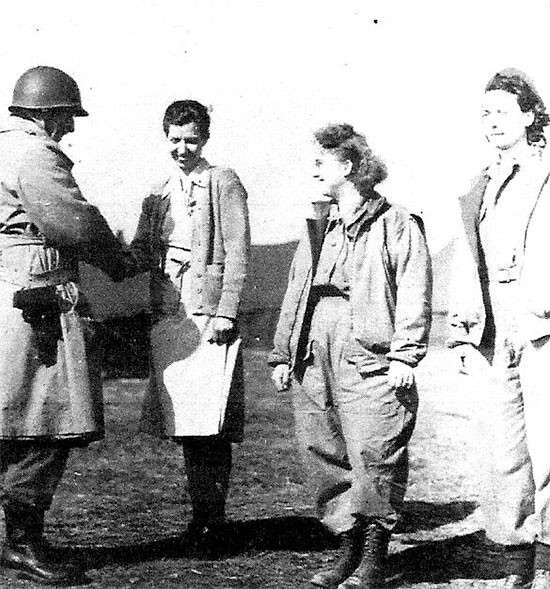
February 21, 1944, picture illustrating the award ceremony during which Major General John P. Lucas, CG, VI Corps, awarded 3 Silver Stars to Nurses, with the first citation honoring a 56th Evacuation Hospital ANC Officer, First Lieutenant Mary L. Roberts, ANC (pictured on the left).
On April 1, 1944, Private Nick J. Gergulas, died as a result of wounds sustained in the air raid of March 29. On April 3, 1944, some men were enjoying a ball game at the rest camp, when enemy shells began to land. The first hit the Patients’ Mess Kitchen, blowing away stoves, dishes, kettles, pots and pans, and dirt. Private Harvin C. Estes was killed instantly! Tragedies were now happening too frequently and anxiety and fear were now beginning to be manifest on the men’s faces. Then on April 6, 1944, the enemy landed more shells in the 56th area, destroying the Post Exchange, Surgical Ward No. 8 again, and the Enlisted Men’s Tents. This time, Technician 5th Grade Peter P. Betley was the victim, who lost both of his legs.
Enemy air raids and long-range artillery shelling caused physical exhaustion and mental breakdown, and a number of the organization’s personnel turned in to the Hospital. At about this time, Lieutenant Colonel Philip W. Mallory, MC, the 56th Evac Hosp Executive Officer, received orders to return to the ZI.
The 56th Evac stopped receiving patients at 1900 hours, April 7, 1944. The unit was to be relieved which was unexpected news. On Easter Sunday, April 9, 1944, the 38th Evacuation Hospital arrived to take over the equipment and the Hospital received orders to move to Nocelleto, Italy. Transfer was completed at 1000 hours the same day, after which the organization entrucked for “Purple Heart Highway” and the shipping lane. The staff and personnel quickly boarded the waiting LCT which pulled away from Anzio’s battered pier, accompanied by another shelling from the “Anzio Express”. A transfer on to a waiting LST was arranged offshore. The trip was rough and through dangerous waters, with high waves, and lots of rain, but remained uneventful. When docking at Pozzuoli the next morning, the sun was shining, and spring looked magnificent. The men were weary but happy to be back!
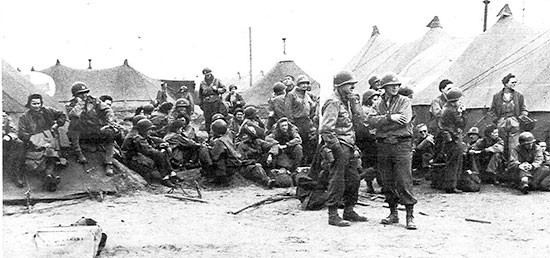
Officers and Nurses of the 56th Evacuation Hospital group outside of Headquarters while awaiting transportation to leave Anzio. The unit’s stay on the Anzio Beachhead is nearly over.
A new hospital complex was opened at Nocelleto on April 12, 1944 at one of the nicest sites the 56th Evac ever had. The men had planted flowers and shrubs throughout the new site and the fruit trees were in full bloom. The first big event at the new site was to celebrate the organization’s first anniversary overseas, and April 24, became a gala. In the afternoon several sports events took place, highlighted by a softball game between the Nurses and the ANC Officers of the 95th Evacuation Hospital. There was a crowd of approximately a thousand spectators, and the 56th team won easily. Many visitors turned up on that day: celebrities, VIPs, Anzio friends, and neighbors. In the evening, supper was served picnic style on the grass to the entire Hospital personnel. The Officers’ and Nurses’ mess tent was transformed into a kind of palm garden with potted shrubs and numerous flowers. There was a dance on a wooden board floor with music provided by the 175th Engineer General Service Regiment band, old friends of the Bizerte days.
The day would have been complete had there not been so many missing because of illness and transfer. Most notable among these was Lieutenant Colonel Henry M. Winans, MC, Chief Medical Service, who had been forced to leave the unit during the last days at Anzio, because of illness (previous CO of the 56th Evac –ed). He had been replaced by Major Edwin L. Rippy, MC, who took over the responsibility for the remainder of the unit’s overseas period. During their stay at Nocelleto, the Nurses were exceptionally granted short rest periods in Naples, at the “Turistico Hotel”, which was very much appreciated by the ladies.
Early in May 1944, the 56th celebrated its second and fanciest overseas wedding when First Lieutenant Marguerite I. Martin, ANC, married First Lieutenant Paul Donnelly, 175th Engineers. Chaplain (Captain) Andrew M. Pronobis, ChC celebrated the wedding ceremony, while Colonel Henry S. Blessé, MC gave the bride away. During this period, patient census was under control. Quite a number of French Colonial troops were treated at the Hospital. For recreation, outdoor movies were shown frequently, baseball games were organized, and USO troupes visited the 56th, including stars such as Marlene Dietrich, Irving Berlin, Danny Thomas, and the Andrew Sisters.
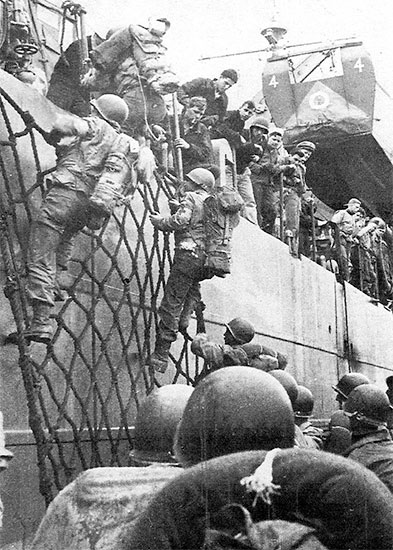
April 9, 1944, Enlisted personnel of the 56th Evacuation Hospital transfer to an offshore LST from an LCT which they initially boarded at Anzio harbor.
The morning of May 15, 1944, Lieutenant General Mark W. Clark attended the 56th Evac’s formal review and presented 18 Bronze Star Medals to staff and personnel for heroic achievements at Anzio, Italy. The Hospital also received a Commendation. It was a memorable occasion.
As the front moved and the Anzio Beachhead forces met the Monte Cassino forces, it left the Hospital far behind the lines, and it was time to leave the gracious valley site. The 56th was due to move again and on May 29, 1944 the organization was on its way by land to Fondi. The journey would take them through devastated villages and small and dusty roads.
The new location was just outside Fondi in a weed patch squeezed between Highway 7 and a war-torn orange grove. It couldn’t be worse. Engineers with bulldozers came to the rescue and leveled the area. The locals, who had taken refuge in the hills during the past five months slowly returned to their homes. They were suffering from starvation, and one of the cooks who spoke Italian was designated to divide the left-overs equally among the families who regularly lined the fences begging for food. Fondi captured by the Allies May 20, 1944, had been heavily bombed the night of May 23-24, seriously damaging vehicles of two Collecting Companies set up by the 313th Medical Battalion (organic unit, 88th Infantry Division –ed). A Clearing Station of the 85th Infantry Division was located five miles west of Fondi during end of May.
For fear of booby-traps, everyone kept out of town. Some men found a small ice cold mill stream that came down from the mountain side. There was also a small cemetery nearby with a lot of German headstones. As usual the front was moving fast and the 56th staff was expecting to be ordered to move soon. Meanwhile, there was good news; Rome, the Eternal City, had been entered by Fifth United States Army troops on June 4.
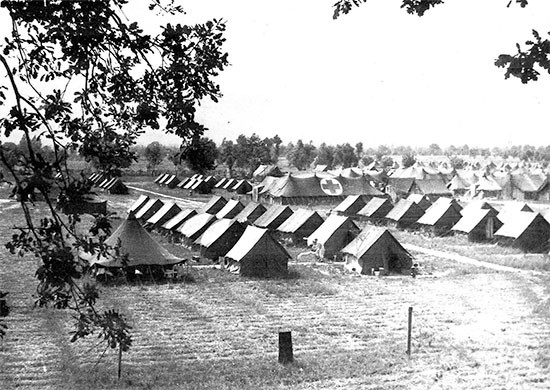
Picture illustrating the 56th Evacuation Hospital site at Nocelleto, where the organization set up from April 12 to May 26, 1944.
The Hospital left for Rome departing Fondi June 6 via Highway 7 which was littered with destroyed equipment, signs of severe tank battles, decaying bodies of enemy soldiers and horses, and destroyed farms and houses. The motor convoy first went from Fondi southwest to Terracina, from which it switched onto Highway 7, passing through deserted farmland, the flooded and ruined Pontine Marshes, devastated Cisterna and Velletri, the Alban Hills, and finally reaching Rome.
The 56th Evacuation Hospital had at last arrived in Rome, one of the first Axis capital cities to fall to the Allies.
The new site was “special”, the “Buon Pastore” Institute, a many-spired building, which was to be shared with the 94th Evacuation Hospital. The place had been used by the Germans, who because of their hurried departure took no pains to leave behind a clean and policed area. Meals were left untouched, medical supplies such as pills, bandages, and sterilizers were left behind, and two bodies of dead German soldiers were found in the morgue. After settling down, everybody had but one wish; to obtain passes to Rome. The staff and personnel were given 6-hour passes, with separate transportation being provided for Officers, Nurses, and Enlisted Men. All wanted to visit Vatican City as well. Pope Pius XII held audiences for Allied troops. Apart from the many exclusive places to visit, a great deal of shopping was done. It was noted that starvation had apparently not touched Rome; moreover the people looked well dressed and the city was clean.
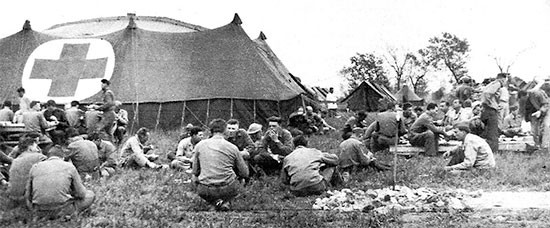
April 24, 1944 First (overseas) Anniversary picnic organized by the 56th Evacuation Hospital for staff and personnel while established at Nocelleto, italy.
Other US Army Hospitals Operating in Rome
6th General Hospital – June 30, 1944 > December 22, 1944
12th General Hospital – June 22, 1944 > November 12, 1944
15th Evacuation Hospital – June 10, 1944 > June 23, 1944
33d General Hospital – June 21, 1944 > September 24, 1944
38th Evacuation Hospital – June 9, 1944 > July 2, 1944
73d Station Hospital – July 5, 1944 > June 18, 1945
94th Evacuation Hospital – June 6, 1944 > June 15, 1944
114th Station Hospital – July 5, 1944 > September 28, 1944
Once more, the Hospital was losing contact with the rapidly moving front, so it was back to packing and awaiting orders for the next move. After packing and waiting, the 56th still waited while wondering if the 6th General Hospital would throw them out.
On June 27, 1944, orders to move arrived and the first trucks made their appearance around 2100. The EM stayed up all night, loading the organization’s equipment, with much difficulty and confusion, due to the use of a single entrance and exit. The motor convoy followed Highway 1 over gentle rolling plains to Civitavecchia, where the captured “Anzio Express” long-range gun was being dismantled for shipment to the Zone of Interior. There was a lot of traffic. At last, the drivers were happy to reach destination, a site near the village of Riotorto, only a few miles southeast of the harbor city of Piombino.
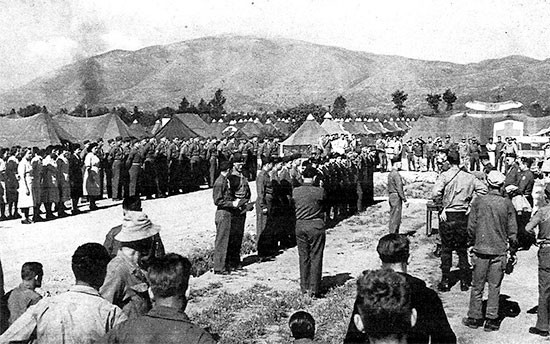
May 15, 1944. Formal review and formation of the 56th Evacuation Hospital attended by Lieutenant General Mark W. Clark who presented 18 Bronze Star Medals to staff and personnel for heroic achievements at Anzio, Italy.
The new bivouac site reached June 29, 1944, was a combination of wheat stubble patches and rows of grapevines. The Hospital, almost immediately swamped with numerous casualties, most of them arriving at night, reminded the personnel of the busy days spent at Avellino, Dragoni, and Anzio.
Fortunately, some recreation was found as the beach was only a 25-minutes walk away. From the beach the Isles of Elba and Monte Cristo could be seen. Outdoor movies were available, and some few were lucky enough to go the Fifth US Army Rest Camp for medical personnel established in Castiglioncello (opened August 3, 1944, only 15 miles south of Leghorn, with capacity for 50 Officers, 25 Nurses, and 100 Enlisted Men –ed). Many of the Medical Corps and ANC Officers started hitch-hiking on cargo and ambulance planes with the intention to do more sightseeing. The war was however not forgotten. Several times, practice air raid alerts were staged around the harbor.
Rumors circulated about plans for an amphibious operation in Southern France, and many members of the command were sure the 56th would be called to participate because of their experience. Late July 1944, a new Officer joined the unit; Major John J. Chizik, MC who became the new Executive Officer. Alert orders came in, and the packing was started. On August 3, 1944 moving orders were received ordering the Hospital to move upward and inland to the village of Peccioli. The convoy experienced some of the worst and dustiest roads yet encountered in Italy.
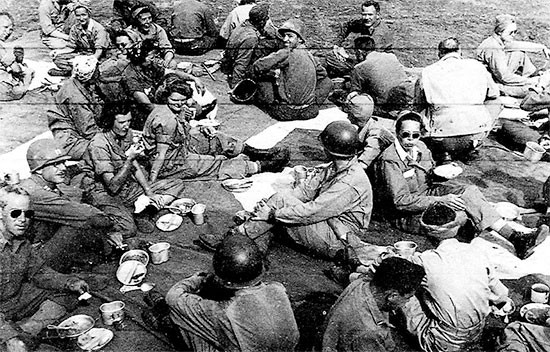
June 1-6, 1944. Picture of 56th Evacuation Hospital personnel having chow on the ground, while stationed at Fondi, Italy.
The new site selected for the Hospital near Peccioli was very secluded. Starting August 5, 1944 the men discovered a field with combined plots of grape vines, apple trees, and cypresses. One of the first patients was a local farmer who had driven his oxen over a landmine. The organization was so isolated that it gradually developed into a little village of its own. Life was full of surprises, as the personnel received a beer ration for the first time, and with it toasted to the Invasion of Southern France, the Liberation of Paris, and General Eisenhower’s prediction that the War in Europe would be over by end 1944! It was here that the 56th received patients of another new organization; the 92d Infantry Division, and one morning Lieutenant General Mark W. Clark appeared to award Purple Hearts to the wounded.
Heavy rains raised much havoc by washing out bridges near the camp, which at times caused the Hospital to become isolated from the only water point, ration dump, and post office. The two Chaplains secluded their quarters and chapel in a shady ravine kept cool by numerous tall poplar trees. Joe Louis, the heavyweight boxing champion visited the organization entertaining a large crowd of patients and personnel. There was also time for recreation, dances, sightseeing trips, and even some shopping for souvenirs.
One day the men were startled by an explosion followed by lots of screaming and wailing. An Italian boy was killed and 7 children injured when a German rifle grenade, with which the child was playing, went off. After Florence had fallen passes were furnished to those who wanted to visit this art center. There were rumors that the 56th Evac would soon be on the move again, and indeed, September 23, 1944 found the command on the road to Scarperia, another village, noted for the manufacture of cutlery, situated about twenty miles north of Florence. The trip brought the Hospital through Pontedera to Empoli; then along the Arno River to Florence; and northward through mountain country to Scarperia, which was reached September 24.
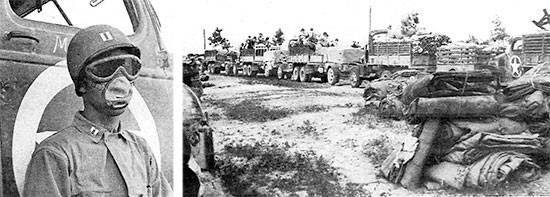
August 3, 1944, personnel of the 56th Evacuation Hospital on their way to Peccioli, Italy, where they would remain until September 23, 1944.
Once more the 56th Evac ended up in a grape orchard, but this time the grapes were ripe! The unit’s kitchen was placed on a potato patch furnishing several good meals. On the first Sunday, ice cream was served much to the delight of everyone. Some concern developed due to the installation of heavy artillery in the neighborhood, however, after several days of fire, the big guns moved out. At first a short stay was expected but the Germans fought fanatically defending Bologna against Allied attacks assisted by the rugged terrain, the Apennines, and the rain, mud, fog, sleet, and finally snow in this mountain range. Battle lines now had only one main route to use for supplies; Highway 65. Patients coming in for treatment now consisted of personnel pertaining to the 34th, 85th, 88th, and 91st Infantry Divisions. As winter gradually approached, it was feared that frontlines would again become stationary.
The Luftwaffe surprised the Hospital complex one moonlit night by giving the nearby Highway a thorough strafing and bombing. The light antiaircraft guns had been moved forward and the raiding enemy realized that this was an occasion that couldn’t be missed. The planes flew quite low, strafing and bombing at will the Highway area that ran by the Hospital, neighboring ammo and supply dumps and convoys. They continued the attack all night and at 0430 in the morning put a 20mm shell in the Enlisted Men’s area that mortally wounded Private First Class Hulon V. Lofton who died at 0800 in the morning. After the attack, the EM moved their quarters away from the Highway to the creek east of the main camp. Just after the tents were pitched, it started to rain, and soon the mud in the area was almost a foot deep!
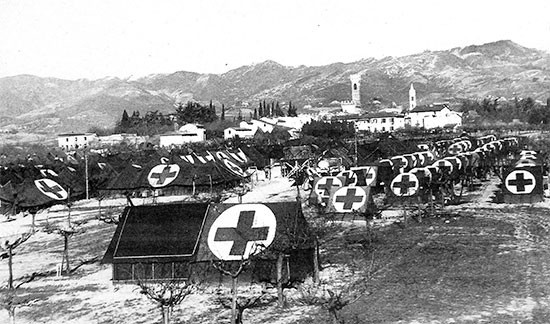
Partial view of the 56th Evacuation Hospital located in a grape orchard, a little south of Scarperia, Italy, where the organization would celebrate Thanksgiving and spend the coming winter. The Hospital’s Commanding Officer, Colonel Henry S. Blessé, was to leave the unit during its stay at Scarperia, after receiving orders to return to the Zone of interior on March 4, 1945.
Plays and shows were available in Florence, and the command distributed passes to go shopping and sightseeing. Several of the organization’s personnel acquired dogs for pets. Officers and Nurses enjoyed the services of Italian waiters in their mess. The continuous rains necessitated work details to gravel the area and install larger culverts to handle all of the water. It then began to get cold and since GI stoves could only be obtained for the wards, the men started building oil burners. Fraternization with the local population was carried out to the fullest, and many would remember the invitations to dinner. The 56th’s second Thanksgiving Day was celebrated in real American fashion, with turkey and all the trimmings served as it should.
Snow was soon expected in the valley, with the hills around the Hospital area already blanketed. The installations were winterized, with the aid of Engineers, who boarded the tent sides and fitted them with doors. The 56th w as all decked out during the Christmas holidays in true Yuletide fashion. The ANC Officers spent a lot of time decorating the wards, and finally snow arrived in time to complete the picture. The EM were given a Christmas party by the Nurses, which included a banquet, a huge tree, a stage show, and presents for all. The following night they organized one for the Officers. Christmas arrived and found everyone full of good spirits, and it should be noted that the season spent at Scarperia was far more cheerful than the dreary holiday period the personnel experienced the previous winter in muddy Dragoni.

Scarperia, April 21, 1945, moving day. 56th Evacuation Hospital Nurses’ area, the ANC Officers are getting ready for the move to Bologna, Italy.
Unfortunately, the year 1944 did NOT see the end of the war in the European Theater as many had expected! In fact, as 1944 ended and 1945 dawned, the optimism had changed to the grim realization that Germany was by no means defeated.
Wind, rain, snow and sleet had negligible effect on the 56th Evacuation Hospital during winter as the installations had been made as comfortable as possible. Work was fairly light because the patient census rarely exceeded 400, and only a small proportion of these were seriously wounded or very ill. This allowed the Officers’ and Nurses’ rest hotels and the Enlisted Men’s Rest Camp in Florence to be well attended.
An important event was to be celebrated as on March 4, 1945, Colonel Henry S. Blessé, MC, the Commanding Officer, received War Department orders to return to the United States. These orders were received with regret by the entire organization. Colonel Blessé had assumed command in May 1942 and run the Hospital through its training days, through maneuvers, and through overseas duty. He left devoted friends and admirers in the 56th Evac and would not be forgotten.
The CO’s departure naturally gave rise to many rumors concerning the unit’s possible future. Transfer to the CBI Theater, return to the ZI, etc. The day after Colonel H. S. Blessé left, the organization’s First Sergeant Billy V. Philips, was discharged and received his commission as Second Lieutenant, MAC.
On the morning of March 18, 1945, the new Commanding Officer, Colonel Kenneth F. Ernst, MC, joined the unit after having been CO of the 2d Medical Laboratory, and the CO of the 15th Evacuation Hospital.
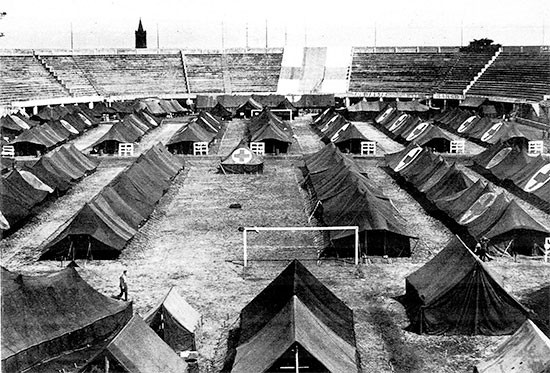
Partial aerial view of the Bologna Stadium occupied by the 56th Evacuation Hospital from April 25 to May 19, 1945.
Easter Sunday, April 1, 1945, was considerably different from the one in 1944. Steel helmets were forgotten, as it was a bright day in spring. Moreover, everyone felt that possibly this could be the last Easter the organization would spend fighting a war. On April 12 the sudden death of President D. Roosevelt, the Commander-in-Chief came as a stunning blow. Thirty (30) days of official mourning started immediately. Due to this sad news, the celebration of the unit’s second anniversary overseas, planned for April 16 1945, was postponed.
On April 16, 1945, Field Marshal Sir Harold R. Alexander broadcast the following message: “The moment now has come for us to take the field for the last battle, which will end the war in Europe.”
Four days later, the great Allied Offensive started through the Gothic Line, and American and British Forces entered Bologna. On April 16, word was received that the city had fallen and that the 56th Evac was to be ready to move out the following day. Dismantling the Hospital was immediately started, and some were convinced that this could well be the unit’s last tactical move … of course, the Po River was still considered a barrier, and there were the Alps. By sundown, the organization was ready to move to Bologna. Staff and personnel were up at 0500 the next morning. A first serial of trucks had arrived and after breakfast equipment was loaded for the move. The motor convoy drove through Futa Pass on Highway 65, which impressed everyone with its scenery. The small villages along the route were in ruins, and some were nothing but masses of rubble. Certain hillsides were so densely pock-marked with shell craters that it looked impossible to find a single square foot of soil that had not been hit by shell fire. The personnel felt a great inner sadness at this view, especially for those of the command who had cared for the soldiers who had so gallantly attempted to break through to Bologna. The war for those men had indeed been hell on earth, and now the men of the 56th Evac were seeing the reasons why.
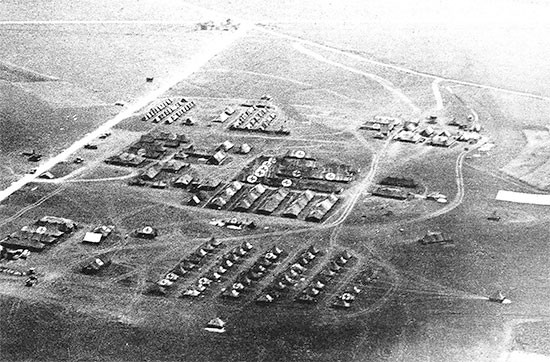
End May 1945, aerial view taken from a liaison aircraft of the 56th Evacuation setup at Udine, north of Trieste, Italy, where the organization would receive its very last patient. The 16th Evacuation Hospital relieved the 56th at Udine on August 4, 1945.
The 56th motor convoy was one among countless other vehicles of all types stretched along the winding road to Bologna. A few miles south of the city the devastation from the intense bombing and shelling became clear. The vehicles crept on at a snail’s pace to the southern parts of the city around sundown. The Hospital was to be set up in one of Mussolini’s stadiums. By darkness the men had eaten their c-rations, unloaded the trucks, piled the equipment, pitched their tents, unrolled their blankets, washed their faces, and flopped into bed.
About 2130 hours, the familiar hum of an enemy plane could be heard in the distance. There were large troop and vehicle concentrations in the vicinity of the stadium, and the GC Red Cross marker had not yet been placed, but everyone believed that this would not have any consequences. However, from this hour until almost dawn the next day a number of German planes appeared and strafed and bombed the roads and troop areas near the stadium. Fortunately none of the Hospital personnel were injured. Nevertheless jangled nerves and a sleepless night were bad enough.
On April 25, 1945 the 56th Evac was ready to operate and the first patients were admitted for treatment. Surprisingly, American casualties were exceptionally light. By April, the tactical situation was moving rapidly as forward elements had already crossed the Po River, while the city of Milan was threatened from two sides by Italian Partisans from within. Following the fighting, enemy patients were admitted to the organization by the hundreds. Some days, scores of unguarded Wehrmacht ambulances drove in the Hospital area, disgorging their patients, and then turned themselves in at the motor pool. This was unbelievable. Soon captured German Medical Officers and Sanitäter worked beside the American personnel in caring for the German sick and wounded!
There was little time for sightseeing in and around Bologna; besides the town had been declared off limits to Allied military personnel. On the Highway back of the hospital site large 10-ton vans loaded with enemy PWs moved southward in an endless stream passing through liberated Bologna. Rumors indicated that Milan would probably be the next stopping place.
On April 30 the unit already received orders to start evacuating all patients and be ready to move. On May 1, 1945, packing was almost complete but patients continued to arrive at the Hospital. Meanwhile, strong wind and rain held up the evacuation of patients by air, and everyone had to wait, wondering whether the move to Milan was going to take place. Orders to pack, move, and unpack and wait were issued, and cancelled, indicating the confusion and excitement at Fifteenth Army Group Headquarters. Verona and Bolzano had been captured and the Brenner Pass blocked. It was now a question of mopping up the torn and tattered remains of the once proud and powerful German and Italian Armies.
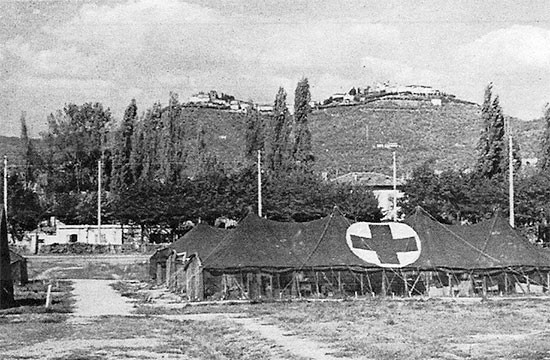
Partial view of 56th Evacuation Hospital Headquarters during its stay at Montecatini, Italy, taken some time early August of 1945.
April 30, 1945, Lieutenant General M. W. Clark announced the big Allied victory to the troops:
Troops of the 15th Army Group have so smashed the German Armies in Italy that they have been virtually eliminated as a military force. This destruction has been accomplished in the offensive which is now 22 days old for the British Eighth Army, and 15 days old for the major part of the Fifth United States Army.
Twenty-five German Divisions, some of the best in the German Army, have been torn to pieces and can no longer effectively resist our Armies. Thousands of vehicles, tremendous quantities of arms and equipment, and over 120,000 prisoners have been captured and many more are being corralled.
The military power of Nazi Germany in Italy has practically ceased, even though scattered fighting may continue as remnants of the German Armies are being mopped up.
A great day arrived when at 0700 hours, May 2, 1945 the radio reported that the war in Italy was over. The collapse of German Armed Forces in northwest Germany, Holland and Denmark, the fall of Berlin, the rumors around Adolf Hitler’s death, and the final “unconditional surrender” of Nazi Germany followed in such rapid succession that it was hard to believe that the war was over! The events of the week from May 2 to May 9, 1945, were so staggering in their impact and importance that President Harry Truman’s historic proclamation before Congress that hostilities in Europe had ceased was received with much relief by all personnel. One job was finished, but a fierce fanatical Japan remained.
By May 12, 1945, the Personnel Section was snowed under with the problem of determining and reporting individual points and scores (ASR, Adjusted Service Rating –ed). The word “Redeployment” was to assume great importance in the days to follow and the Point System was well received by the command.
Immediately following the German surrender in Italy (signed May 2, 1945, at Caserta, Italy), elements of Fifth United States Army moved out to the different borders, primarily for the purpose of rounding up enemy prisoners and preserving order. US Divisions advanced to the French border, patrolled the Swiss frontier, while other units reached the Austrian border. British Eight Army moved to the Yugoslav border to back up their occupation of Trieste. Each of the Divisions were supported by their own organic Medical Battalions and by one or more mobile Army Hospital unit.

August 1945. During an impressive formation, Fifth United States Army Surgeon, Colonel Charles O. Bruce, MC, presented Colonel Kenneth F. Ernst, CO 56th Evacuation Hospital, the Meritorious Service Unit Plaque, for superior performance of duty in the accomplishment of exceptionally difficult tasks, from March 1 to April 30, 1945, in Italy (the official date of the award was July 5, 1945).
On May 17, the CO received word that the 56th Evac would be moving north to Udine, north of the city of Trieste. Sadly, most men had anticipated going into a rest bivouac near some beautiful Italian lake. Udine was north, all right, but this was certainly not a trip to rest and recreation by any means. It was discovered by the command that relations between Italy, the Allies, and Yugoslavia had become severely strained. Trieste and some other small Italian towns had been occupied by Yugoslav Partisans claiming the territory as their own. Consequently, Allied troops were being rushed to the sector, and should fighting ensue, the 56th would serve as the nearby hospital. Needless to say, everybody was discouraged, upset, and angry to think that the organization might be involved in another war…
The major part of the organization’s personnel and equipment arrived at the new hospital site located about three miles east of Udine on May 20, 1945. The 225-mile trip from Bologna was long and tiring. The Hospital was established on a spacious gently rolling plain covering approximately forty acres, beautifully situated. Upon arrival red-scarved (Communist Party members –ed) Italian and Yugoslav Partisans were parading through the streets and countryside, heavily armed. The situation was very tense and rumors varied from peaceful talks and agreements to reports of armed clashes and artillery duels. Because of this, Allied troops started pouring in with aircraft and armor. Every possible effort was made to impress Tito’s Government that the Allies meant business and that the Trieste incident should be settled peacefully. Since the patient load was not too heavy, personnel were invited to take trips to the various rest centers in the country. Although quotas were limited, the lucky few managed to visit Cannes, Alassio, Nice, Lago Maggiore, or Venice, and if time permtted, it was possible to travel to Austria as well. Charming Venice, only two hours drive from Udine, was seen by all members of the command, as the CO had made provisions for daily transportation to this unique city where streets were mostly replaced by canals.
On June 5, 1945, the 56th got proof that the Point System worked with Private First Class Joe E. Frederick being the first man to start home under the “Redeployment Plan”. Many more were to follow. On June 13, tragedy struck the organization, when two of the unit’s favorite Enlisted Men; Technician 5th Grade William A. Hoffer and Private First Class William Milanowitz were killed and Technician 5th Grade Carl A. Moon seriously injured in a truck accident. “Blackie” Hoffer had been the organization’s baker, and had been with the 56th from the day it was activated. “Bill” Milanowitz was one of the cooks, and both men deserved praise for the fine meals they always prepared. Moreover, their work had contributed so much to improve morale and organizational spirit.
As the days passed more of the unit’s men left Udine to return home. Twelve (12) men left in one group on June 15, and on June 26, all men who had reached 85 points or more were transferred to other organizations.
The 16th Evacuation Hospital relieved the 56th at Udine on August 4, the last day for admitting patients. In 25 months of continuous foreign service the 56th Evacuation Hospital had admitted and cared for 73,052 patients, a record which was unsurpassed by any Evacuation Hospital in either the Mediterranean or European Theaters of Operations.
During the final days of the stay at Udine, Lieutenant Colonel Christopher B. Carter, MC, Chief of Surgical Service, received WD orders to return to the ZI.
By September 1, 1945, all Fifth US Army units had been assigned to the Peninsular Base Section (PBS) and starting September 9, Fifth Army became non-operational and was finally inactivated October 2, 1945.
The 56th Evac, initially planned to become a Pacific Theater reserve unit, had now arrived at the Montecatini Redeployment and Training Area on August 6, 1945. After a short period of training covering the aspects of Pacific and jungle warfare, the unit was to prepare for departure. The command had high hopes that final destination would be the United States. The last days at Montecatini passed rapidly, with lectures, athletics, formal retreats, rifle practice, enemy tactics, physical tests, training films, filariasis and dengue fever, It was an “old familiar tune” to many in the command. During the latter part of their stay in this pleasant center and resort town, the 56th Evac was given a Citation for superior performance of duty during the final Po Valley offensive. Before an impressive formation, Fifth United States Army Surgeon, Colonel Charles O. Bruce, MC, presented Colonel Kenneth F. Ernst, MC, the Meritorious Service Unit Plaque.
The 56th Evac was finally sent home to the ZI for inactivation early in October 1945. The ANC complement left Naples aboard the S/S Vulcania, a former Italian luxury liner, leaving on September 25, 1945 for the United States.
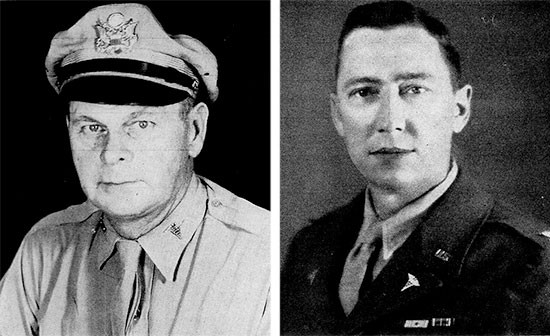
Left: Colonel Henry S. Blessé, MC, CO 56th Evacuation Hospital, May 4, 1942 – March 4, 1945. Right: Colonel Kenneth F. Ernst, MC, CO 56th Evacuation Hospital, March 18, 1945 – September 20, 1945.
Personnel Roster:
Officers
| ADAMS, George, Capt., MC | KELLY, John J., 1st Lt., MAC |
| ALESSANDRA, Samuel A., Capt., MC | KINZER, Hazel M., 2d Lt., ANC |
| ALLMAND, Eugenia, 1st Lt., ANC | KRAUTKRAMER, Valerie, ARC |
| AINSWORTH, Ellen G.,, 2d Lt., ANC | La DUE, Charles N., Capt., MC |
| ALLSUP, Gwen L., 1st Lt., ANC | LEBERMANN, Lowell H., Maj. MC |
| ARMSTRONG, Madge K., 1st Lt., ANC | LEE, Lonette M., 2d Lt., ANC |
| ARNOLD, Hugh F., Capt., MC | LYKINS, Farrel M., 1st Lt., ANC |
| ARONS, Leonard A., Capt., MC | LYON, Mary J., 1st Lt., ANC |
| BAIRD, Lucas J., 2d Lt., MAC | MALLORY, Philip W., Lt. Col., MC (first Executive Officer) |
| BALTZER, Catherine L., 1st Lt., ANC | MARTIN, Marguerite I., 1st Lt., ANC |
| BASS, Loretta W., 1st Lt., ANC | MARTINAK, Richard E., Capt., MC |
| BEIDLEMAN, Ada, 2d Lt., ANC | MAXFIELD, Doris, 2d Lt., ANC |
| BELL, Weldon E. Maj., DC | McCAULEY, Morris D., Maj., MC |
| BERTRAND, Lucille B., 2d Lt., ANC | McCLEARY, Gordon S., Capt., MAC |
| BLESSE, Henry S., Col., MC (second Commanding Officer) | McCLUNG, Hugh L., Capt., MC |
| BOLES, William M., Maj., MC | McCULLOUGH, Helen A., 1st Lt., ANC |
| BOND, John P., Capt., MC | McMAHON, Lillian, 2d Lt., ANC |
| BOSWELL, Helen F., 2d Lt., HD | MEADORS, Dorothy F., Capt., ANC (second Chief Nurse) |
| BOWYER, Mack F., Capt., MC | MECHAM, Jack L., 1st Lt., MAC |
| BRAKE, Ira F., Capt., MC | MERRICK, Benjamin A., Capt., MC |
| BRASELTON, Vernie, 1st Lt., ANC | MESSIER, Eveline T., 2d Lt., ANC |
| BROWN, William W., Jr., Capt., MC | MOORE, Elsie L., 1st Lt., ANC |
| BUSSEY, Charles D., Maj., MC | MOSELEY, Sybil M., 2d Lt., ANC |
| CARNISH, Dorothy L., 2d Lt., ANC | NAHL, Maryles, ARC |
| CARPENTER, Myrtle, 1st Lt., ANC | NEUFELD, Vilma R., 1st Lt., ANC |
| CARTER, Christopher B, Lt. Col., MC | PETERSON, Carl A., Capt., MC |
| CHIZIK, John J., Lt. Col., MC (second Executive Officer) | PFEIFFER, Helen F., 1st Lt., ANC |
| COCHICK, Madeleine D., 1st Lt., ANC | PHILIPS, Billy V., 2d Lt., MAC |
| COLLINS, Lawrence D., Capt., MC | PINTO, Joseph A., Capt., MC |
| COMBITES, Inez R., 1st Lt., ANC | POWERS, Frances E., 1st Lt., ANC |
| COOKE, Eunice A., 1st Lt., ANC | PRONOBIS, Andrew M., Capt., ChC |
| CRAIG, Rose C., 1st Lt., ANC | RABE, Meta M., 1st Lt., ANC |
| CRAVEN, Jack C., Capt., MAC | RAYMOND, Frances V., 1st Lt., ANC |
| CRONIN, Julia A., 2d Lt., ANC | REA, Marguerite T., Capt., ANC (first Chief Nurse) |
| DAGIT, Avis L., 1st Lt., ANC | RICHEY, Jean M., 1st Lt., ANC |
| DAHL, Clenora B., 1st Lt., ANC | RINGO, Alice C., 1st Lt., ANC |
| DEAVERS, Doris L., 1st Lt., ANC | RIPPY, Edwin L., Lt. Col., MC |
| DENNIS, Thelma, 1st Lt., ANC | ROBERTS, Kenneth V., 1st Lt., MAC |
| DEVEREUX, William P., Maj., MC | ROBERTS, Mary L., 1st Lt., ANC |
| DOHERTY, Edward W., 1st Lt., MC | ROSALES, Genevieve,1st Lt., ANC |
| DORSEY, Mary Ann, 1st Lt., ANC | ROSEN, Samuel R., Capt., MC |
| DUNLAP, Hudson J., Maj., MC | ROWE, Robert J., Capt., MC |
| Du PONT, Isabelle H., 1st Lt., ANC | SANDERS, Mary H., 1st Lt., ANC |
| ERNEST, Kenneth F., Col., MC (third Commanding Officer) | SEBASTIAN, Festus J., Maj. MC |
| FISHER, Rowan E., Capt., MC | SCHAKELFORD, Rich T., Lt. Col., MC |
| FORD, Sylvester, Capt., MC | SHAW, Martha C., 1st Lt., ANC |
| FRASER, Amy C., 2d Lt., ANC | SKILES, William V., Capt., MC |
| FRIED, Hattie L., 1st Lt., ANC | SKROH, Victoria M., 1st Lt., ANC |
| GADBERRY, Ruby, 1st Lt., ANC | SMALL, Andrew B., Maj., MC |
| GALT, Jabez, Capt., MC | SNYDER, Mary F., 1st Lt., ANC |
| GALT, Sidney, Maj., MC | SOPER, Clarence E., Maj., QMC |
| GORDON, Daniel F., Capt., DC | SPILLMAN, Anna M., 1st Lt., ANC |
| GRAVES, Anna E., 1st Lt., ANC | SPRINGER, Frances L., 1st Lt., ANC |
| GRAY, Marjorie E., 1st Lt., ANC | STUTHEIT, Eliz J., 1st Lt., HD |
| GRIFFITH, George C., Capt., ChC | TATE, Martha N., 1st Lt., ANC |
| GRIFFORD, Ruth G., 2d Lt., ANC | TEAGUE, Madge M., Capt. ANC |
| GRUSSING, Lena, 1st Lt., ANC | THOMAS, Hattie M., 1st Lt., ANC |
| HAHN, William B., Capt., MC | THOMPSON, Jo P., 1st Lt., ANC |
| HARDY, Winifred G., 1st Lt., ANC | TURNBOW, William R., Capt., MC |
| HAYNES, Frances, 2d Lt., ANC | WALKER, Herman A., Maj., MAC |
| HENEHAN, Mary C., 1st Lt., ANC | WALSH, William R., Capt., MAC |
| HEWLING, Frances, 2d Lt., ANC | WARDEN, Sheba B., 1st Lt., ANC |
| HICKS, C. J. Jr., Maj. DC | WATSON, Eula A., 2d Lt., ANC |
| HILLIARD, George L., Lt. Col., MC | WELLS, Gideon R., Capt., MC |
| HUGHES, Helen L., 1st Lt., ANC | WHITE, Byrd E. Jr., Capt., MC |
| HUNGERFORD, Ruth C., 1st Lt., ANC | WILLIAMS, Sue, ARC |
| HURD, Donald L., 1st Lt., MC | WILLIS, Raymond S., Maj., MC |
| JEFFERSON, Nancy, 1st Lt., ANC | WINANS, Henry M., Col., MC (first Commanding Officer) |
| JOHNSON, Robert H., Capt., MC | YOUNG, Tennie, 1st Lt., ANC |
| JONES, Elmer K., Capt., MC | ZURNEY, Mary L., 2d Lt., ANC |
| JONES, Marshall L., Lt. Col., DC |

Left: Dental clinic.
Center: Dispensary.
Right: Laboratory.
Enlisted Men
| ALEXANDER, Morton, T/5 | KAHLER, Theodore, T/5 |
| ALLEN, John T., Pfc | KEETON, Sam E., T/5 |
| ALM, Norman O., T/5 | KELLY, Charles M., T/5 |
| ALMEIDA, Tomas F., T/5 | KENNEDY, Faye H., Pfc |
| ALVES, Lee, T/4 | KENNEY, Earl E. Jr., T/4 |
| AMOS, Charles E., Pfc | KENNON, Travis H., Pfc |
| ANDERSON, Louis A., T/3 | KEPLEY, Kenneth L., Pfc |
| ANGELL, Robert H., T/Sgt | KESERICH, John, T/Sgt |
| APKING, Earl A., T/4 | KESZEY, George P., T/5 |
| ATTEBERRY, Marion F., M/Sgt | KEYS, Robert G., Pfc |
| AVILA, Anthony P., Pfc | KING, Chester B., Pfc |
| BAKKEN, Howard K., Cpl | KING, Gerald A., Pfc |
| BALLARD, Bernard L., Sgt | KIRCHNER, Carl J., Pfc |
| BALDERAS, Andrew C., Pfc | KLEINSCHMIDT, William F., T/5 |
| BANEY, Cecil B., T/4 | KNEBLIK, Nickola A., T/4 |
| BARBER, Harry C., WOJG | KOHLSTEDT, Eldon E., Pfc |
| BARKER, Delbert E., T/3 | KOON, Chalmer A., Sgt |
| BATES, Frank, Pfc | KOSTELNY, Martyn, Pfc |
| BENSON, Marvin D., Pfc | KOTOWSKI, frank J., Cpl |
| BERGER, Thomas C. Jr., T/4 | KOUBA, Albert, Cpl |
| BERGMAN, Floyd F., T/4 | KOVALECZ, Walter L., T/4 |
| BERNARD, Raymond, Pvt | KRAMER, Eugene J., Sgt |
| BERRY, Donivan R., T/4 | KRAUSE, Robert E., Pfc |
| BETLEY, Peter P., T/5 | KREIMAN, Carl M. Pfc |
| BIEL, Casimir I., Sgt | KRIKORIAN, Leo S., T/5 |
| BIRCHARD, Robert M., T/3 | KRUMMENACHER, Ralph K., Pfc |
| BISULKO, Joseph J., Cpl | KUBUS, Joseph T. Jr., T/3 |
| BITNER, Herman A., T/5 | KUHN, Alfonso N., Sgt |
| BLACK, Homer A., S/Sgt | KUYKENDALL, Hulet C., T/4 |
| BODIN, George L., Pfc | LADZINSKI, Alex A. Pfc |
| BOLEN, Aaron C., T/4 | LALONDE, Daniel D., Pfc |
| BORSVOLD, Leonard A., T/5 | LAMB, Walter C., T/4 |
| BOTLEY, Charles T., Pfc | LAMBERT, Robert G., T/3 |
| BRADSHAW, Norman E., Pfc | LANDSLAW, Earl H., T/5 |
| BRANSOM, Dalton E., T/3 | LASKEWICH, Nick, Cpl |
| BRENNER, LaVaine E., Pfc | LAWRENCE, Orval R., Cpl |
| BRETZ, Gerald C., T/4 | LEDFORD, Quinton L., Pfc |
| BREWER, Clinton K., S/Sgt | LEE, Olford A. Jr., Pfc |
| BREWER, William M., T/4 | LEFEVERS, Sam P., T/4 |
| BROOKS, Henry D., Pfc | LENHART, Harold F., Cpl |
| BROWN, Floyd J., Pfc | LEONARD, Leo, Pfc |
| BRUNNER, William A., T/5 | LEWIS, Ernest H., T/4 |
| BUCK, Bernice W., Sgt | LIERMANN, Henry C., Pfc |
| BUHL, John L., T/5 | LIGGETT, Virgil T., T/4 |
| BUJARSKI, Chester J., Pfc | LINDHOLM, Wesley K., T/4 |
| BUKOVAC, John, Pfc | LINDQUIST, Charles A., T/5 |
| BURKE, Edward F., Pfc | LINDSTROM, Clyde H., T/5 |
| BURT, Paul D., Cpl | LINGER, Dana H., Pfc |
| BUSH, Francis W., T/Sgt | LINKUGAL, Robert J., Pfc |
| BUSHY, Kenneth E., T/5 | LIPSKY, Abraham H., Pfc |
| BYE, Arthur R., T/3 | LISTON, Wilbert J., S/Sgt |
| CAMPOS, Francis H., T/5 | LOFTON, Hulon V., Pfc |
| CANNARELLA, Jack, Cpl | LONG, James C., T/3 |
| CARAPELLATTI, Edward J., Pfc | LOPER, Eugene S., Pfc |
| CARBAUGH, Clarence E., T/4 | LUCAS, Robert C., T/4 |
| CARLSON, Harry W., T/5 | MAKOSKI, Casmer, T/4 |
| CARNES, Wilbur L., Pfc | MAKOVSKY, Leo T., Pfc |
| CATOZZI, Raymond E., T/4 | MANCUSO, John Jr., T/5 |
| CEBULA, John T., Pfc | MANLEY, Wayne A., Pfc |
| CHAMBLISS, Troy C., T/4 | MAPEL, Charles T., Pfc |
| CHAPA, Abelardo, Pfc | MARK, Leo B., T/5 |
| CHAPMAN, John R. F., Sgt | MARKSTROM, Earl W., T/3 |
| CHARLES, Sam, S/Sgt | MARRINER, Richard M., T/Sgt |
| CHRISTIE, Anthony G., Pfc | MARTIN, Dewey R., T/3 |
| CICHUCKI, Alphonse A., Pfc | MARTIN, Milton A., T/4 |
| CLAUSSEN, Duane C., Pfc | MAXWELL, Floyd L., Pfc |
| CLEATON, Lee Roy W., S/Sgt | MAXWELL, Loyd E., Pfc |
| COBBLE, Grady L., Sgt | MAY, Cyril P., T/3 |
| COLLINSWORTH, William H., T/5 | McCAFFETY, Thomas W., T/5 |
| CONKLIN, James E., Pfc | McCORMICK, James P., Sgt |
| CONROY, Arthur T., Pfc | McDONALD, Wayne L., T/5 |
| CORSON, Charles J. Jr., Pfc | McMURTERY, Blair, Pfc |
| COURTNEY, Clement F., T/Sgt | MIELKE, Harold V., Cpl |
| COWAN, Myron L., T/5 | MIHALIK, Paul B., Pfc |
| COX, Jackson R., Pfc | MILANOWITZ, William, Pfc |
| CROSSWHITE, Caleb L., S/Sgt | MILLER, Walter L. A., Cpl |
| CRUMP, Jack, T/3 | MILLOTTE, John A., T/5 |
| DALTON, Charles G., Sgt | MITCHELL, Billie T., T/5 |
| DAVENPORT, Albert C., Pvt | MITCHELL, Veyne P., T/4 |
| DAVIDSON, Albert E., T/4 | MITERKO, Peter R., T/5 |
| DAVIS, Jack, Cpl | MODA, Louis A., Pfc |
| DAVIS, John C., T/Sgt | MOON, Carl A., T/5 |
| DeBAGGIS, Vincent J., Pfc | MOORE, James E., Pfc |
| DIAZ, Ricardo J., Pfc | MORGAN, Morton M., Pfc |
| DIXON, Herman T., Pfc | MURPHY, William J., T/4 |
| DODD, William H., Pfc | NELSON, John D. Jr., T/5 |
| DOMINICK, Mike., Pfc | NOLAN, Thomas J., T/4 |
| DONALD, James F., Pfc | NORDWALL, Richard, T/4 |
| DOUBLET, Anthony A. Jr., Pfc | NORIEGA, Agapito M., Pfc |
| DROBECK, Edward T., Pvt | NOSEK, Robert J., Pfc |
| DUNHAM, Orval E., Sgt | NULL, Kenneth E., Pfc |
| DUNTON, Arthur D., Cpl | OBST, Arthur, Pfc |
| EINECKE, Wilfred E., T/3 | OGDAHL, George T., Cpl |
| ENGELMAN, Frank E., S/Sgt | OLIVAS, Manuel R., Pfc |
| EPTON, James J., T/5 | OROSZ, Frank J., Cpl |
| ESTES, Harvin C., Pvt | OSBORNE, John J., Pfc |
| EVANS, Kenneth L., Pfc | OZMUN, Cloyd J., T/5 |
| EVANS, Vernon D., T/5 | PADULA, Anthony, T/5 |
| FARRAR, David J., Pfc | PAGE, Andrew J., Pfc |
| FILTER, Elmer C., T/3 | PARKER, Earl E., Pfc |
| FISCUS, Lester S., T/Sgt | PARSON, Floyd M., Pfc |
| FORESTER, Virgil C., Pfc | PAXTON, Charles A., T/3 |
| FORTENBERRY, Willis, T/4 | PAYNE, Charles G., Cpl |
| FOWLER, Dale C., Pfc | PECK, William D., Pfc |

| FOX, Jack, T/5 | PEERY, Sebron A., T/4 |
| FRANCIS, Robert E., T/5 | PEREZ, Gregorio, Pvt |
| FREDERICK, Joe E., Pfc | PHILLIPS, Hallos A., Pfc |
| FREEMAN, Alex H., Pfc | PHILLIPS, Robert R., Pvt |
| FREEMAN, Bonnie J., T/4 | POLECKI, Joseph S., T/5 |
| FRYE, Bernard L., Pfc | POLLY, Audie M., T/5 |
| FULTON, Raymond R., Pfc | POTTER, Curtis F., T/4 |
| FURR, Truman A., T/4 | PRASEK, Louis J., T/5 |
| GAINOR, Russell E., Pfc | PRESLEY, Marvin A., T/5 |
| GARCIA, Marcos, Pfc | PRITCHETT, Herman E., Pfc |
| GARDNER, Robert H., T/5 | PROSCH, Harry C., T/5 |
| GATLIN, Lloyd M., S/Sgt | PRUITT, John H., T/3 |
| GERGULAS, Nick J., Pvt | PUFF, Raymond V., T/4 |
| GEYER, Frederick S., T/5 | PUGH, Lloyd, Pfc |
| GIBBS, Chester F., Sgt | PULASKI, Carl A., T/4 |
| GIBSON, Claude A., Pfc | RANUS, John Jr., Pvt |
| GILMOUR, John C., T/5 | RATYNSKI, John S., Pfc |
| GOMEZ, Clifford C., T/4 | RICONO, Peter L., Pfc |
| GONZALEZ, Rene J., T/5 | RILEY, Clarence J., Pfc |
| GRIFFITH, Eldon E., T/4 | RIZZUTO, Ernest, T/5 |
| GRISNIK, Paul J., T/4 | ROBB, William H., S/Sgt |
| GRISSOM, Max W., Pfc | ROBINSON, Harry L., Pfc |
| GROMMES, John B. Jr., T/5 | RODRIGUEZ, Nick V., Pfc |
| GROVES, Elbert D., T/Sgt | ROMERO, Carl A., T/3 |
| GUERIN, Robert B., T/5 | ROTMAN, Leroy M., T/5 |
| GUIDRY, George D., Cpl | ROY, Henry S., T/3 |
| GUINTHER, Floyd D., T/4 | SANDERS, Jazy W., Pfc |
| HAAS, Melvin R., Pfc | SCHOENFELDER, Wilfred H., Pfc |
| HAHN, John H., T/4 | SELESKI, John J., T/4 |
| HALBROOKS, Neillie J., Pfc | SHATTUCK, George M., Pvt |
| HALE, Orville L., T/4 | SHEELEY, Fred, T/5 |
| HALL, Ollie R., Pfc | SHERBACH, Stanley W., Pfc |
| HALL, William O., Pfc | SHERMAN, Harry, Pvt |
| HAMEL, Arthur, Pfc | SIDORAK, Andy Jr., Cpl |
| HAMILTON, Charles M., T/Sgt | SILK, Willis L., T/5 |
| HAMILTON, Raymond H., Pfc | SILVERMAN, Samuel M., T/5 |
| HANNIGAN, Edgar D., Pfc | SIMONTON, George H., Pfc |
| HANSING, Marlyn D., Pfc | SIMPSON, Warren L., Pfc |
| HANSON, Coy, Pfc | SKUMURSKI, Edward R., T/3 |
| HARTSOG, Edward R. Jr., T/5 | SLAVING, Ernest E., T/4 |
| HAWKINS, Benjamin L., T/5 | SNIDER, James N., Pfc |
| HEATH, Everett R., T/5 | SOBIESKI, Henry L., T/3 |
| HEIMER, Hubert L., T/Sgt | SOKOL, Joseph, Pvt |
| HELSLEY, Robert M., T/4 | SPENCE, Kenneth E., Pvt |
| HIGHT, Robert L., Pvt | SPERENZA, James A., Cpl |
| HIGHTOWER, Lloyd A. H., Pfc | SPILLMAN, William H., Cpl |
| HILL, William O., Pfc | SPRAY, Claude, Pfc |
| HJELT, Arvid J., T/5 | SPRENG, Charles A., T/5 |
| HOBAN, Edgar F., T/4 | STAYNER, Laurence E., Pfc |
| HOCK, William M., Pfc | STEELE, Alton E., T/4 |
| HOFFER, Elias J., Pfc | STUTSMAN, Donald J., T/3 |
| HOFF, William M., T/5 | SUTCLIFFE, Glenn L., Cpl |
| HOFFER, William A., T/5 | SWEGZDA, John L., T/3 |
| HOHLFELD, Otto A., Pfc | TAYLOR, Johnnie D., Pfc |
| HOLCOMB, Jack M., Sgt | TEAGUE, Bascom R., T/5 |
| HOLDER, Eugene E., Pvt | TURNER, Clifford R., Pfc |
| HOLTRY, William H., Cpl | TWIDALE, Malcolm E., Pvt |
| HOPPER, James N., Pfc | VANOY, Luther C., Pfc |
| HORLYK, Emil, Pfc | VERDOORN, Emery A., T/4 |
| HORN, Jack, S/Sgt | VERTIN, Kenneth F., Pfc |
| HORNE, Sylvester L., T/4 | VILLANI, Henry, Pfc |
| HUELF, James M., T/5 | VOORHEES, Wright V., F/Sgt |
| INCE, Theodore E., Pfc | VOSS, Victor J., T/5 |
| INSKEEP, Charles M., T/4 | WALKER, Elbert L., Pfc |
| IRVIN, Harold J., T/4 | WALTON, George, T/5 |
| JACKSON, Oliver V., T/5 | WEST, Wallace L., T/5 |
| KACKSON, Wilbur, Pfc | WHEELEHAN, Joseph P., Cpl |
| JADWINSKI, Frank, Pfc | WHEELER, Leo F., T/5 |
| JARAMILLO, Ray, Pvt | WHITAKER, Clarence O., Pfc |
| JARESH, Billy H., Sgt | WHITAKER, Wilford, Pfc |
| JARVIS, Genole J., T/5 | WILSON, Lafayette A., T/4 |
| JEAN, Floyd C., Cpl | WIRE, Curtis H., Pvt |
| JIMMIE, Bernardo T., Pfc | WONG, Jim Y., T/5 |
| JOHNSON, Gerhard F., Pfc | YATES, Hubert, Pfc |
| JOHNSON, Hilbert E., Pfc | ZANDERHOLM, Edwin R., Pfc |
| JOHNSON, J. T., Pfc | ZARNOTH, Albert W., Pfc |
| JOHNSON, Morris E., T/4 | ZIEMNIK, John H., T/5 |
| JONES, Harold F., T/5 | ZIMMERMAN, James L., Pfc |
| KACZMARSKI, Paul J., Pfc |

Left: Patient ward.
Center: X-Ray service.
Right: Registrar office.
Commanding Officers – 56th Evacuation Hospital
Lt. Colonel Henry M. WINANS, MC (August 1, 1940 > May 1, 1942)
Colonel Henry S. BLESSE, MC (May 4, 1942 > March 4, 1945)
Colonel Kenneth F. ERNST, MC (March 18, 1945 > September 20, 1945)
Meritorious Service Unit Plaque – 56th Evacuation Hospital
Fifth United States Army, dated July 5, 1945, presented at the Montecatini Redeployment & Training Area
Official Campaign Credits – 56th Evacuation Hospital
Naples-Foggia
Anzio
Rome-Arno
North Apennines
Po Valley
Personnel Losses – 56th Evacuation Hospital
Second Lieutenant Ellen G. Ainsworth, ANC (Anzio, Italy, February 16, 1944)
Technician 5th Grade William A. Hoffer (Udine, Italy, June 15, 1945)
Private First Class Hulon V. Lofton (Scarperia, Italy, October 4, 1944)
Private First Class William Milanowitz (Udine, Italy, June 13, 1945)
Private Harvin C. Estes (Anzio, Italy, April 3, 1944)
Private Nick J. Gergulas (Anzio, Italy, April 1, 1944)
Units Served – 56th Evacuation Hospital
Fifth United States Army
Seventh United States Army
Fifteenth Army Group
II Army Corps
IV Army Corps
VI Army Corps
82d Airborne Division
1st Armored Division
First Special Service Force
2d Armored Division
1st Infantry Division
3d Infantry Division
9th Infantry Division
34th Infantry Division
36th Infantry Division
45th Infantry Division
85th Infantry Division
86th Infantry Division
88th Infantry Division
91st Infantry Division
92d Infantry Division
10th Mountain Division
442d Infantry Regiment (Nisei) (Separate)
3d Ranger Battalion
The MRC Staff wish to express their sincere thanks to Joe Davis, son of Technical Sergeant John C. Davis (ASN:37186997), who served with the 56th Evacuation Hospital throughout World War Two, for providing them with a copy of the “The Story of the 56th Evac”, which enabled them to edit a concise Unit History of subject Hospital. His generous contribution was very much appreciated.
